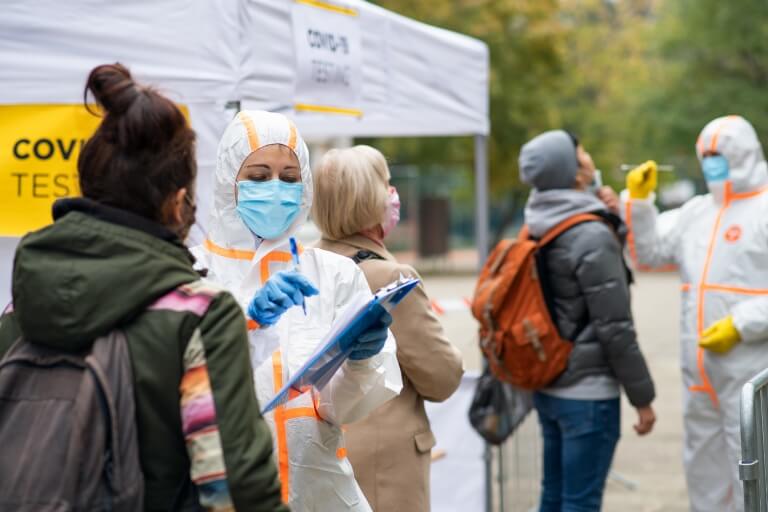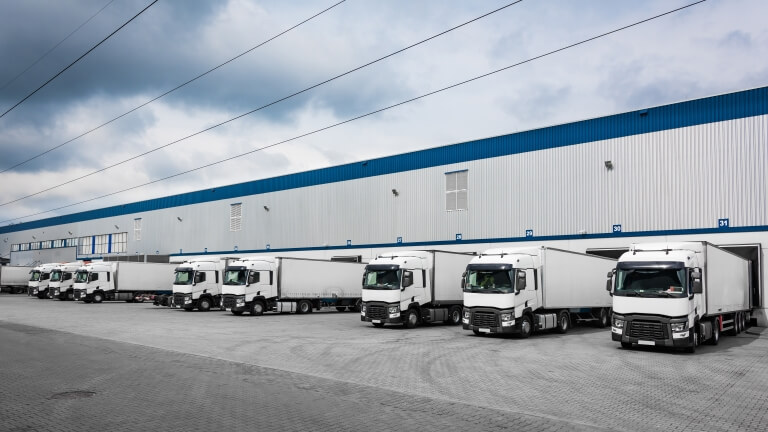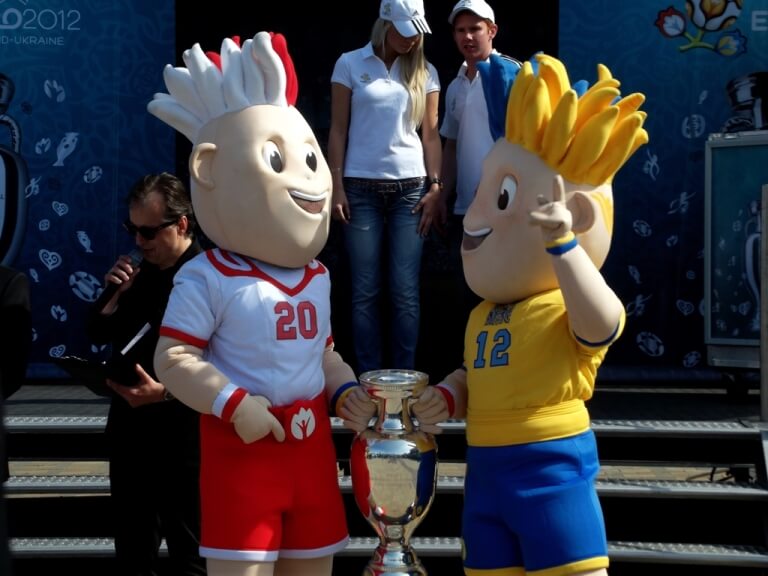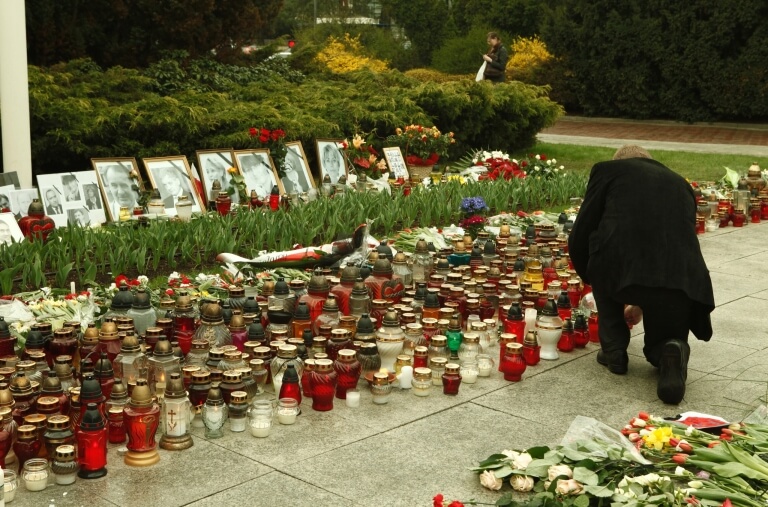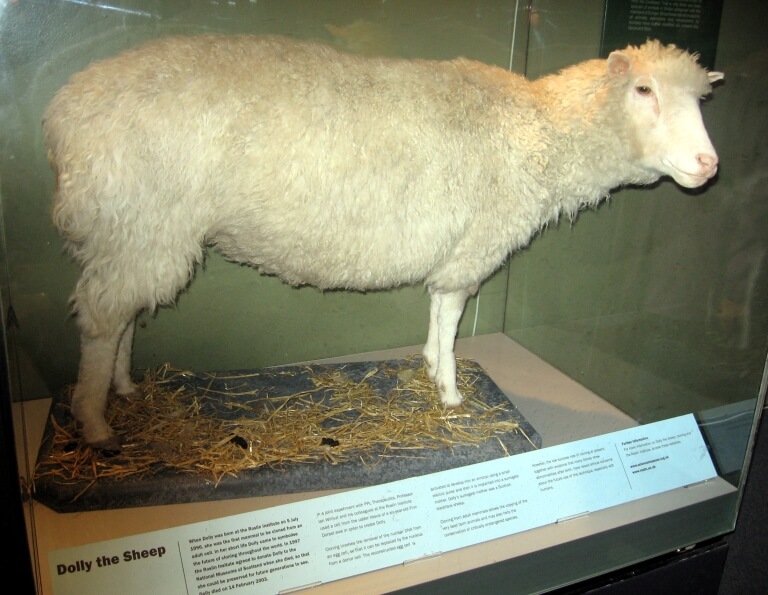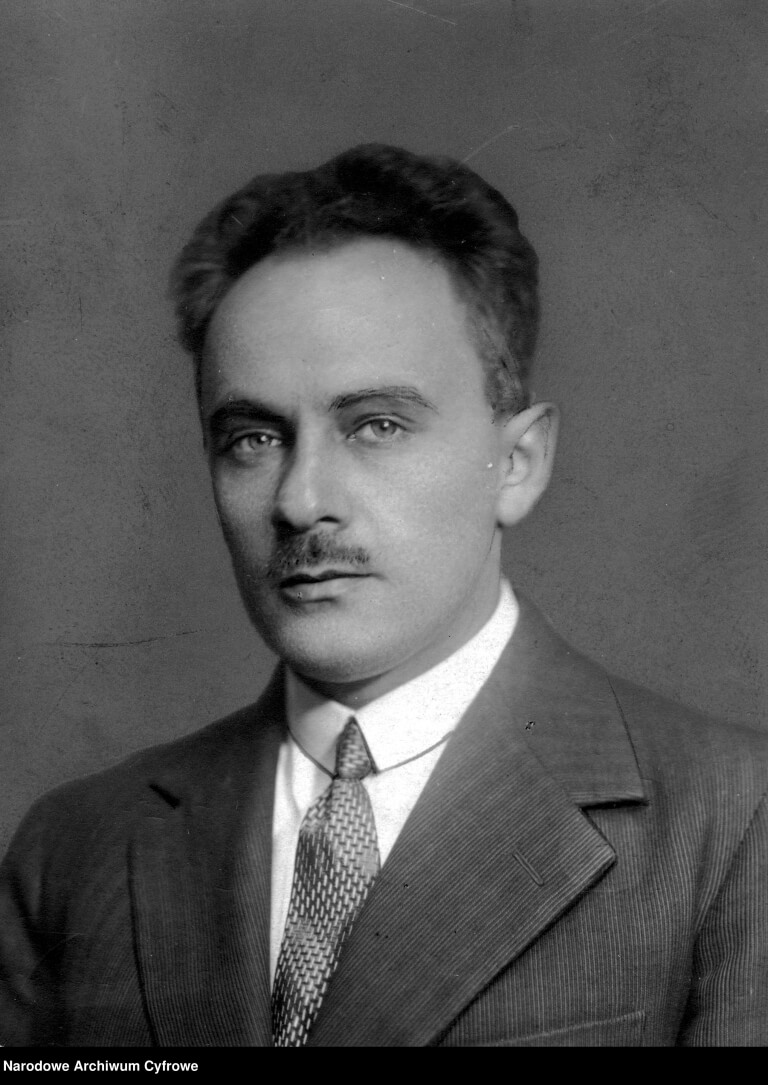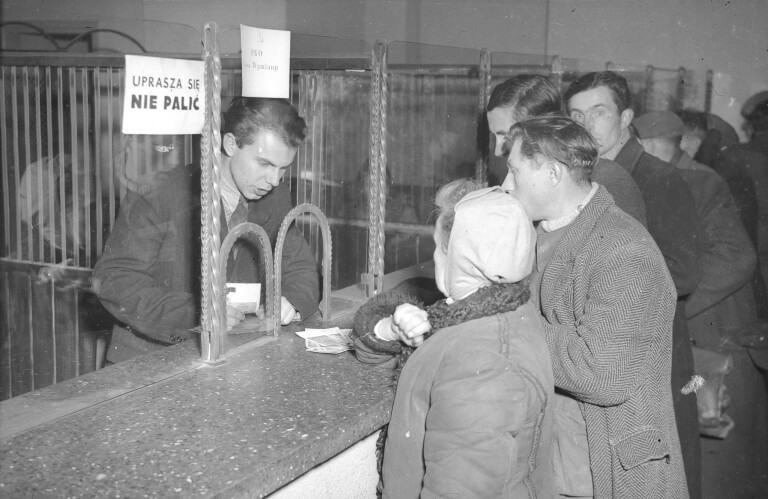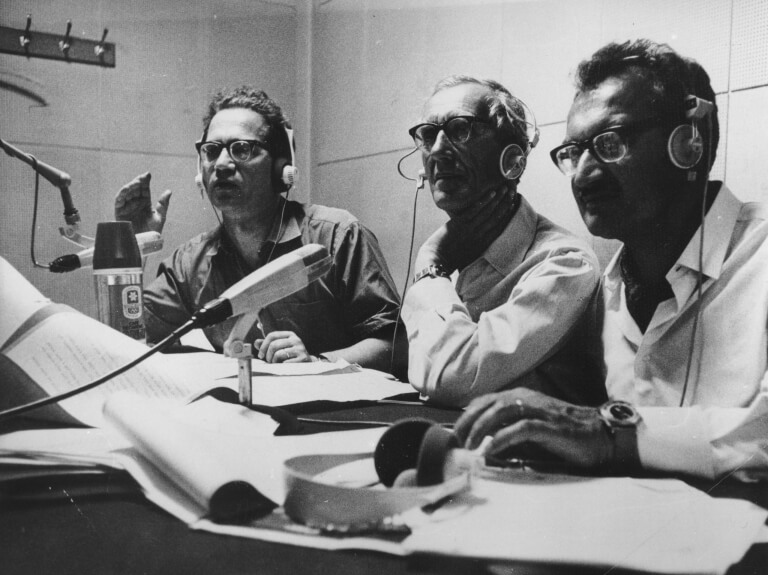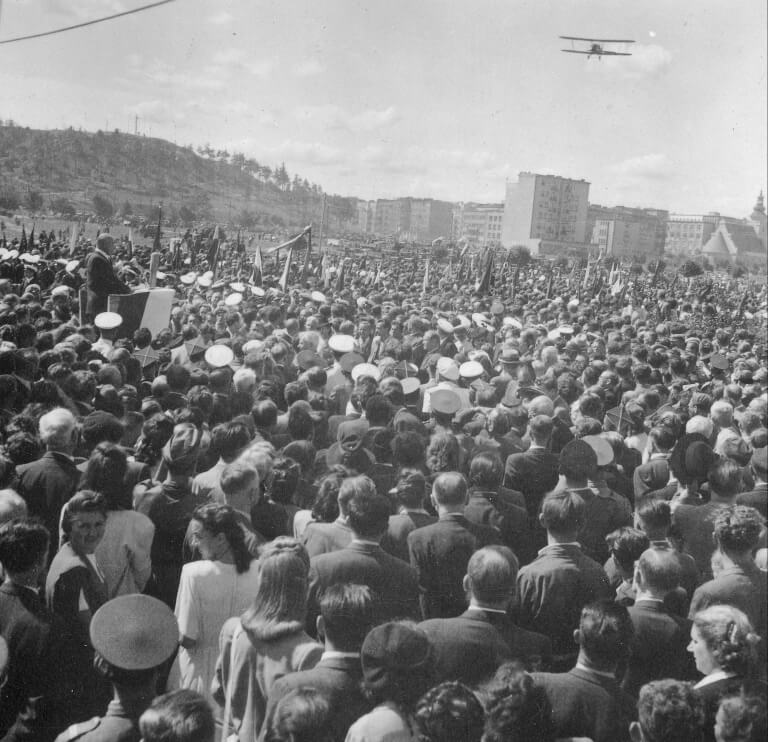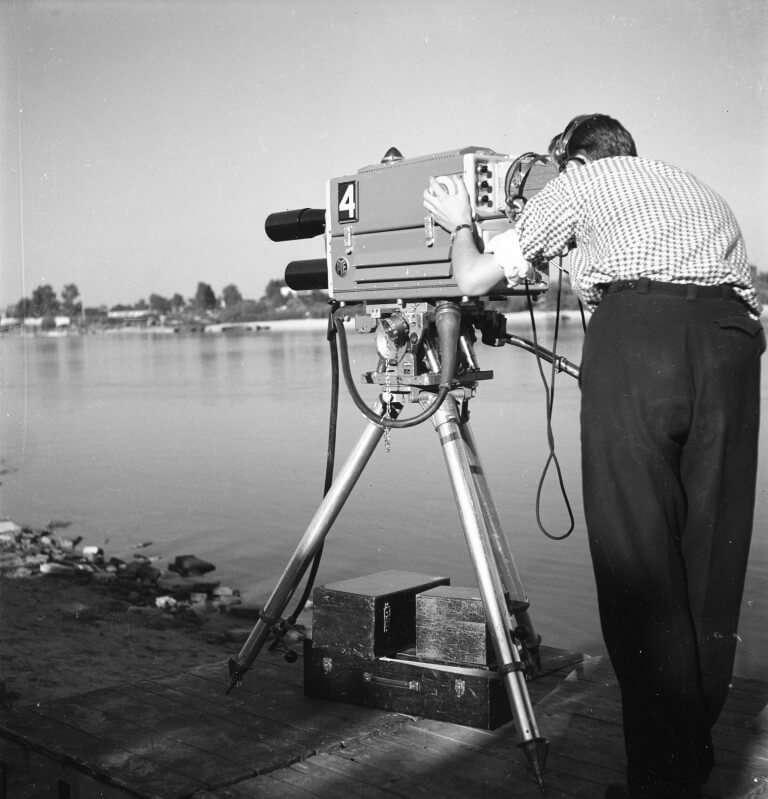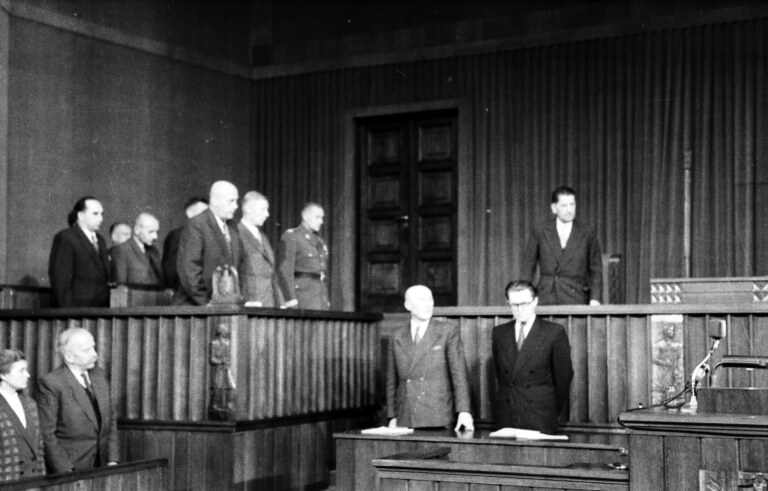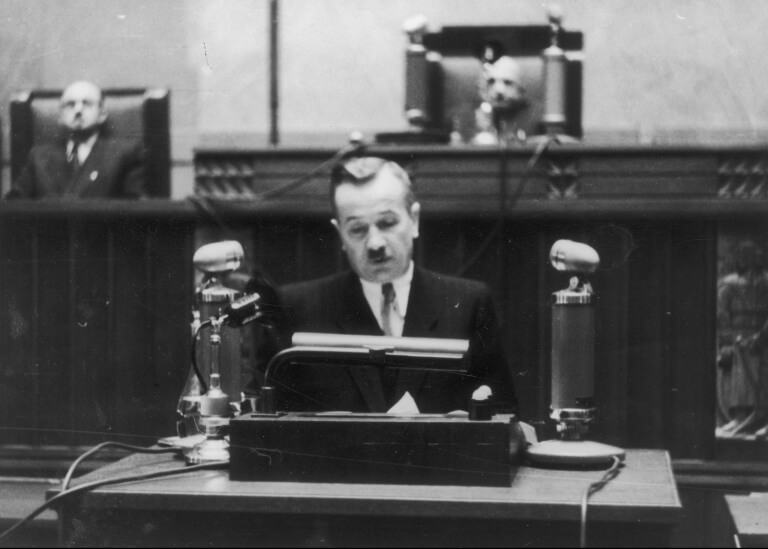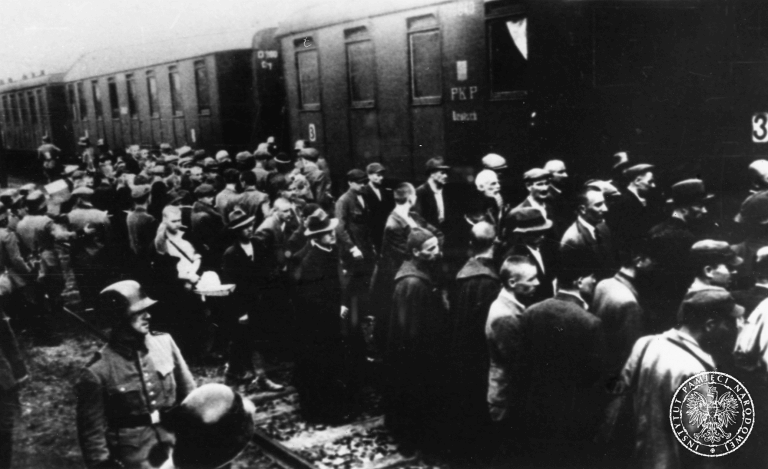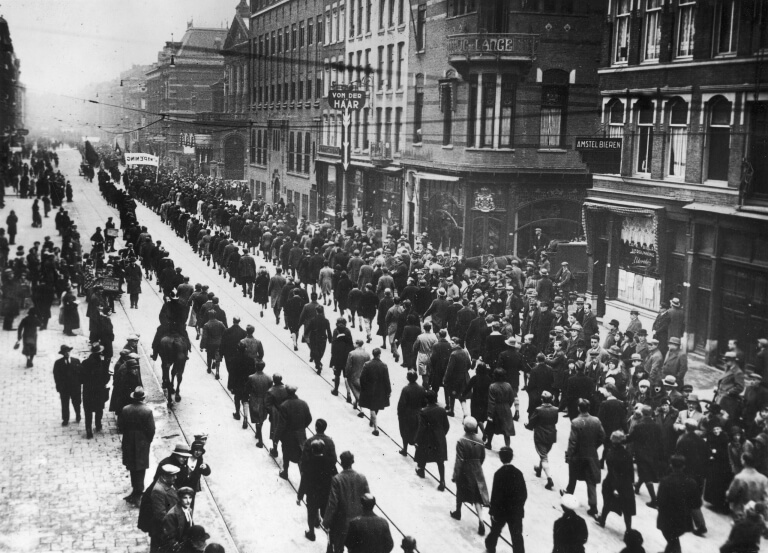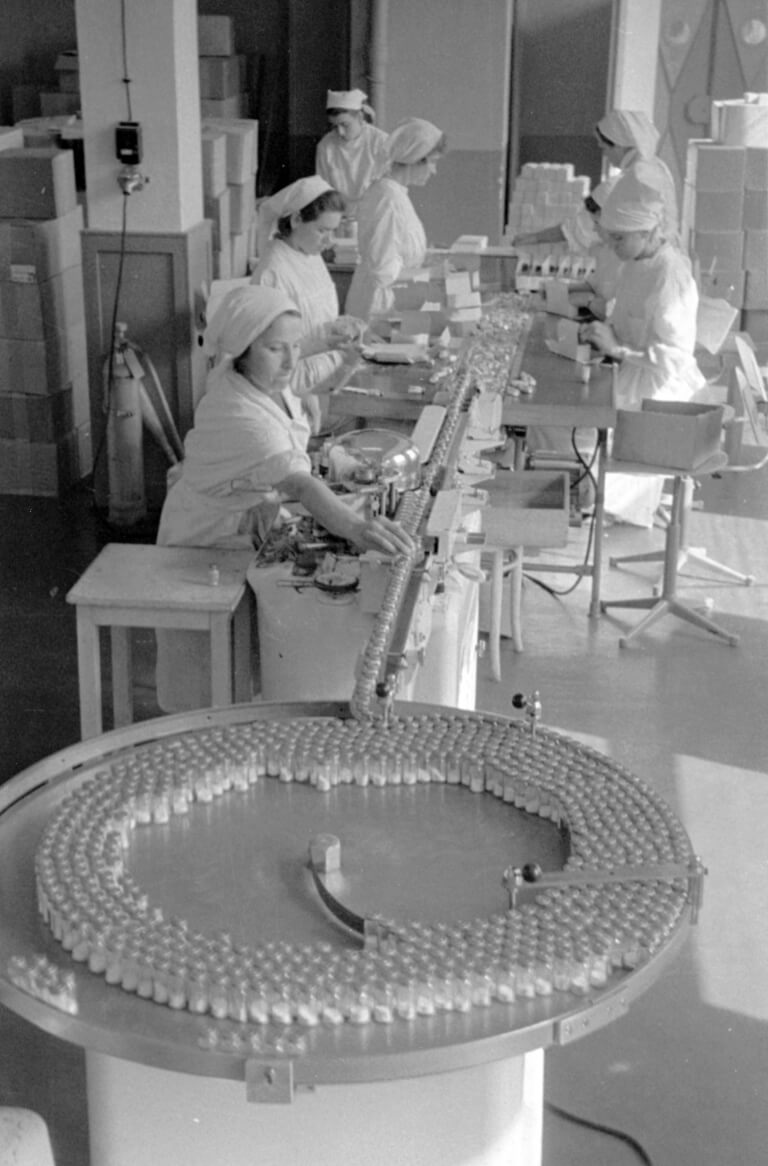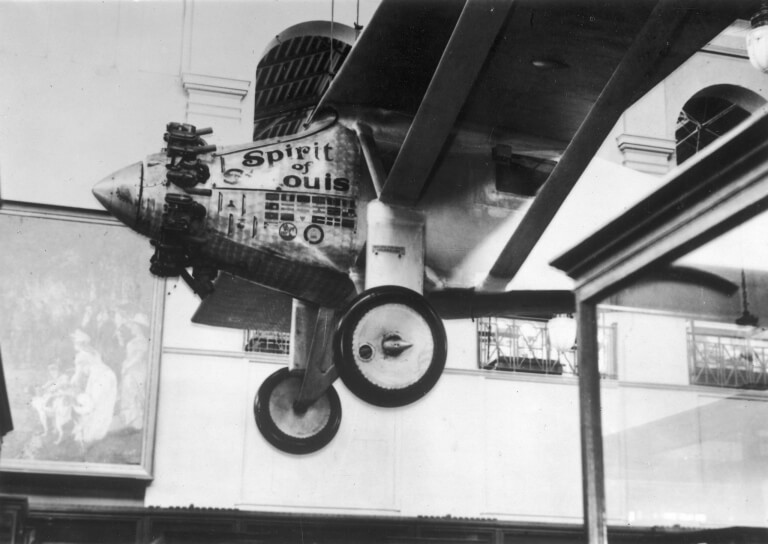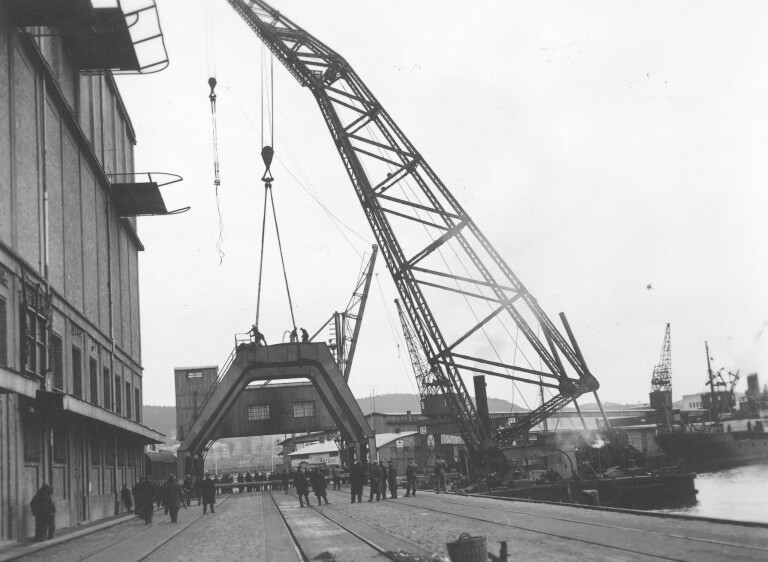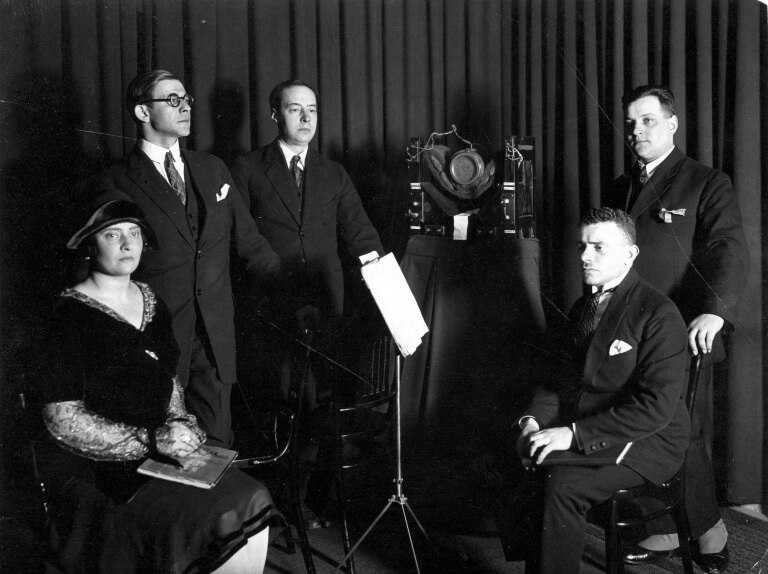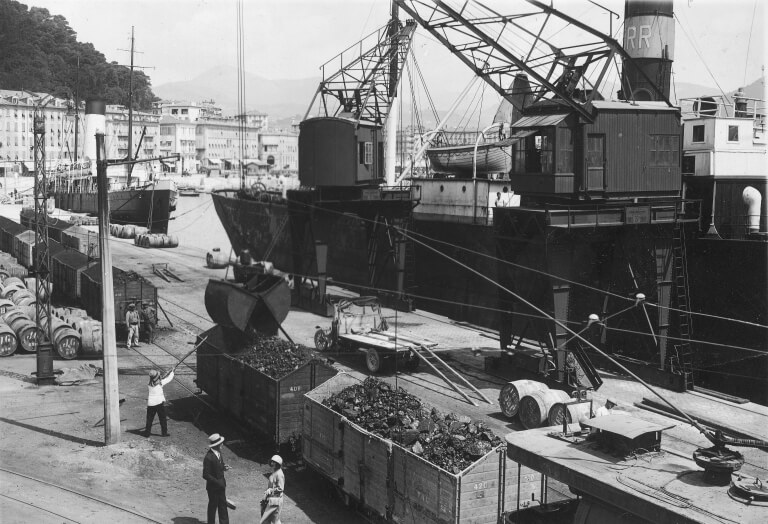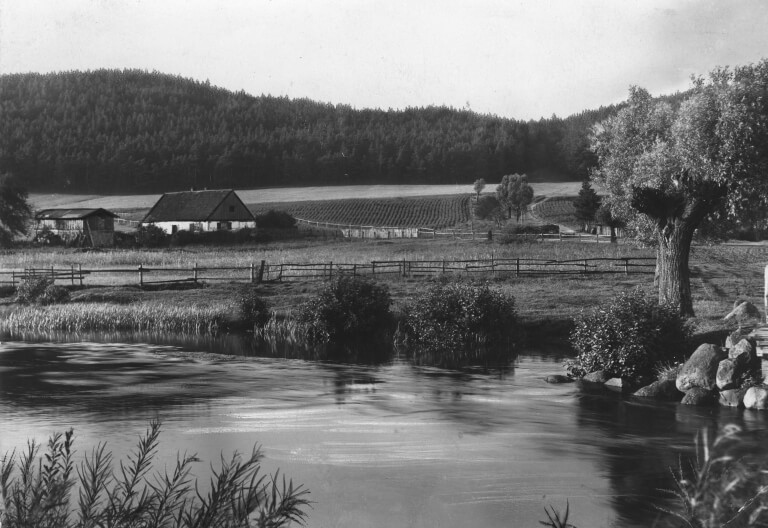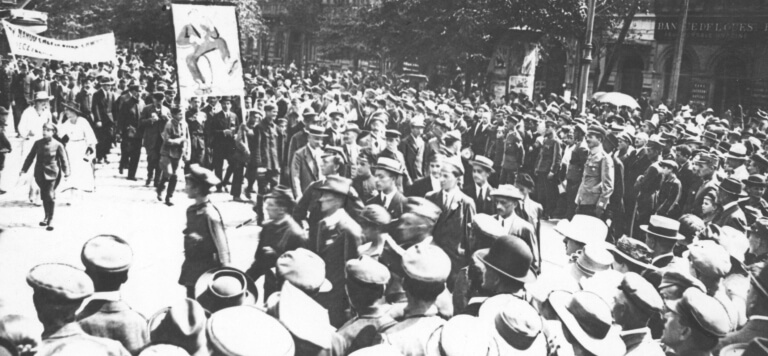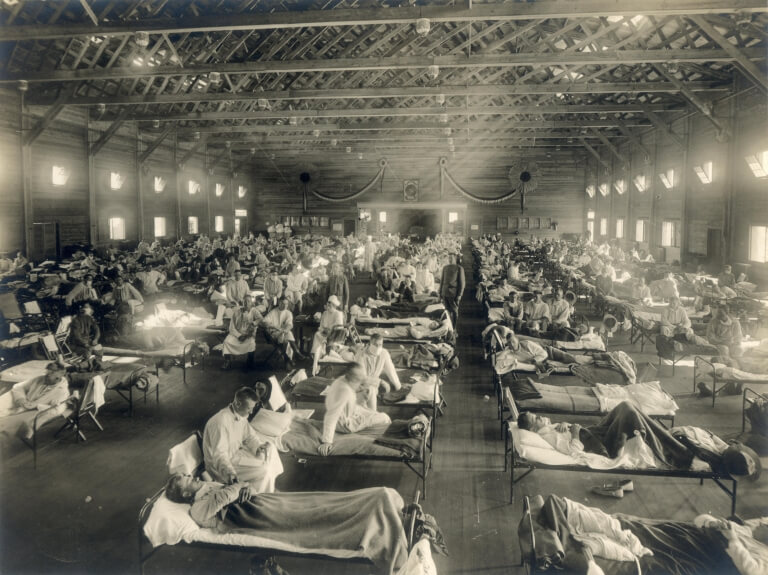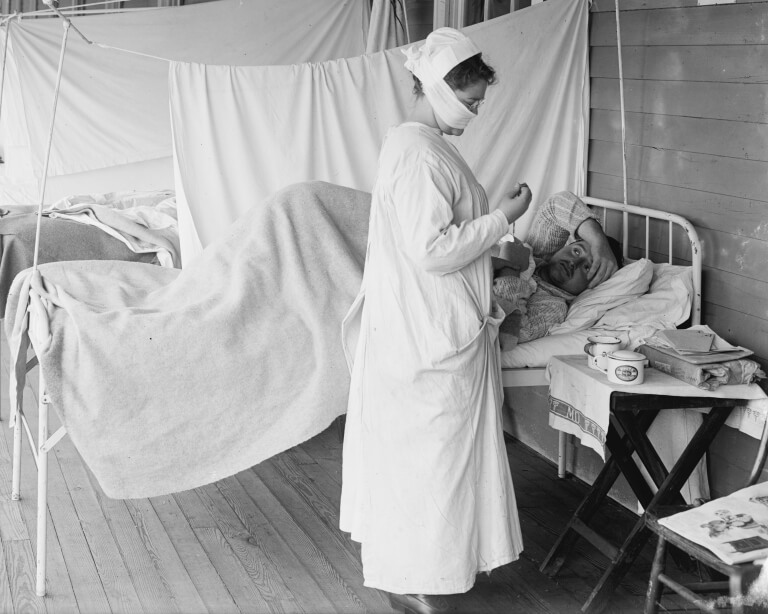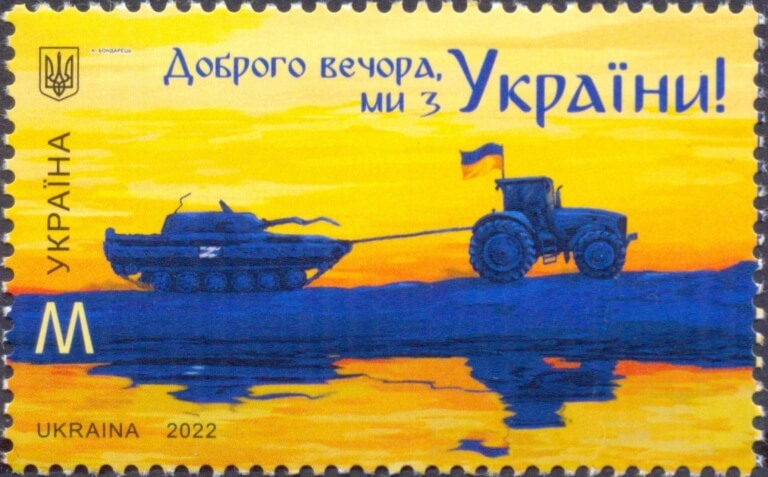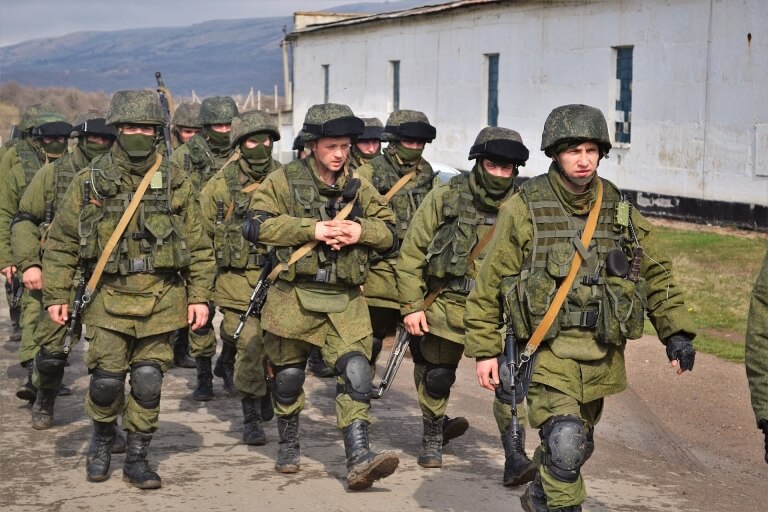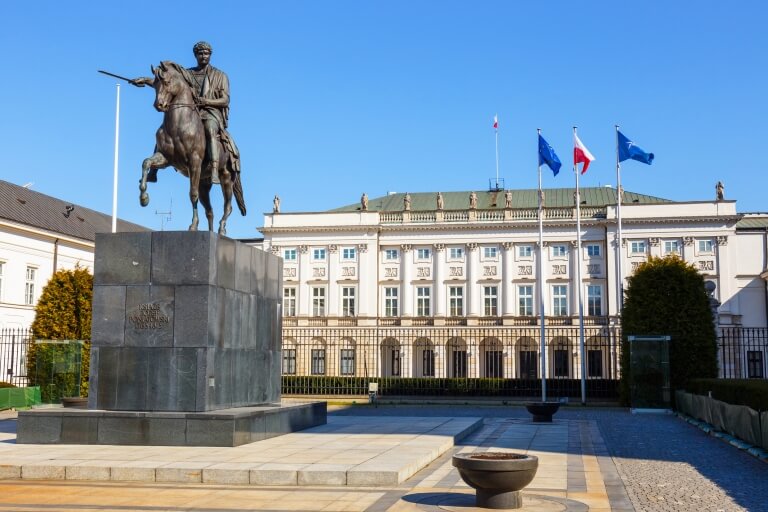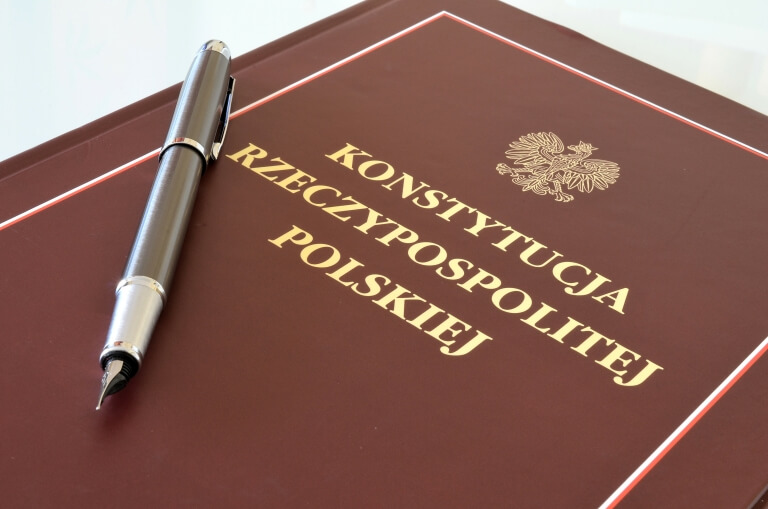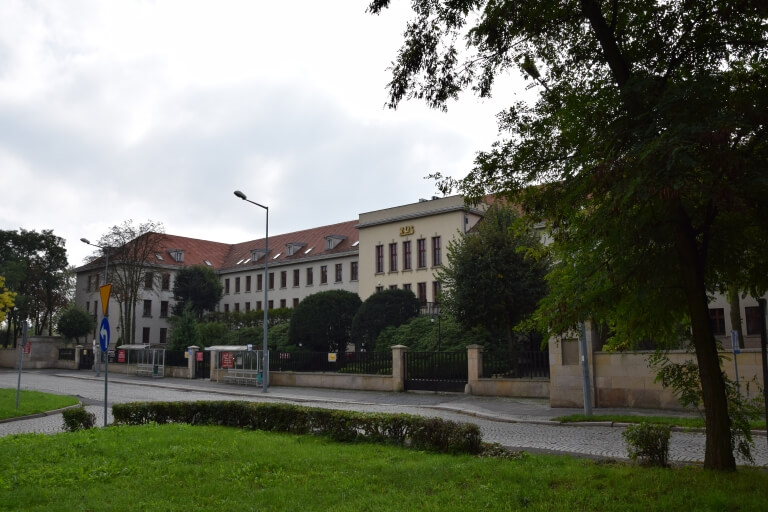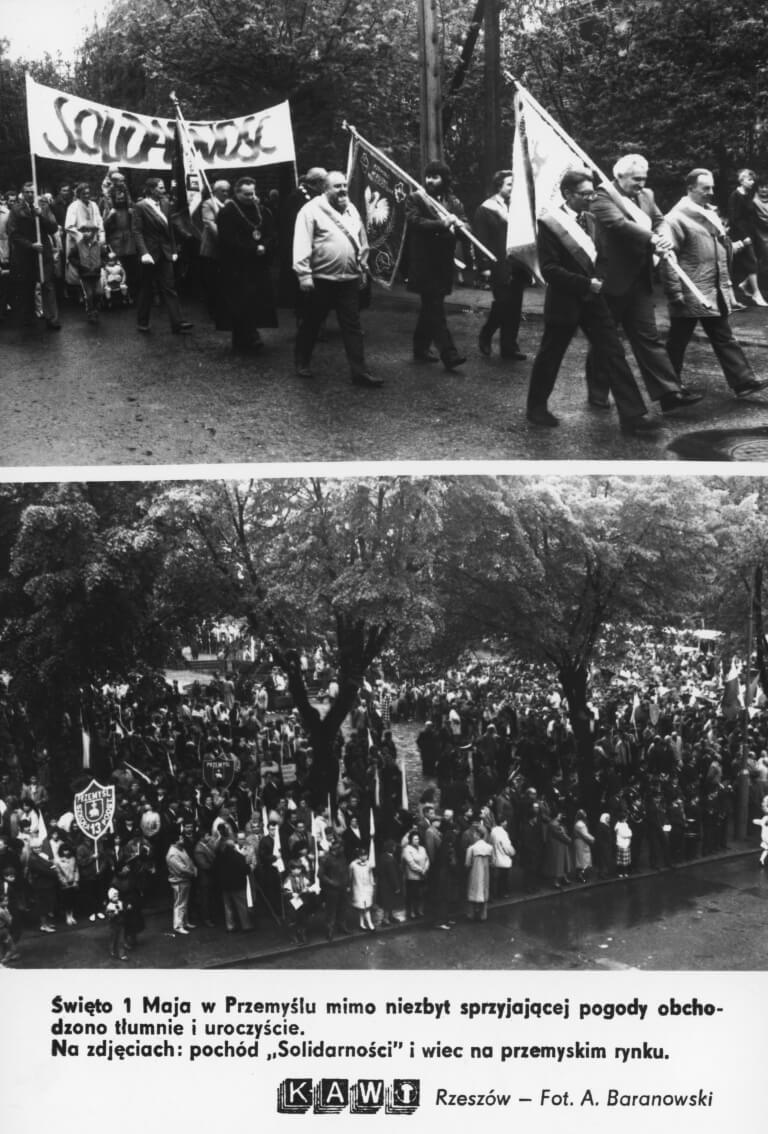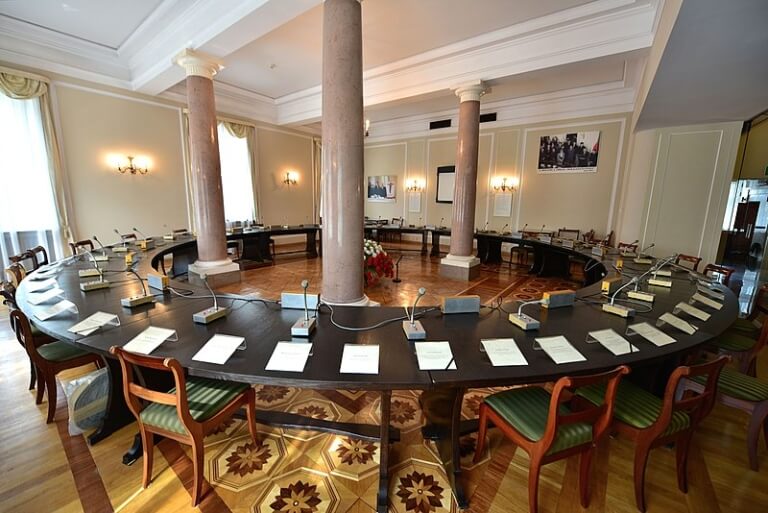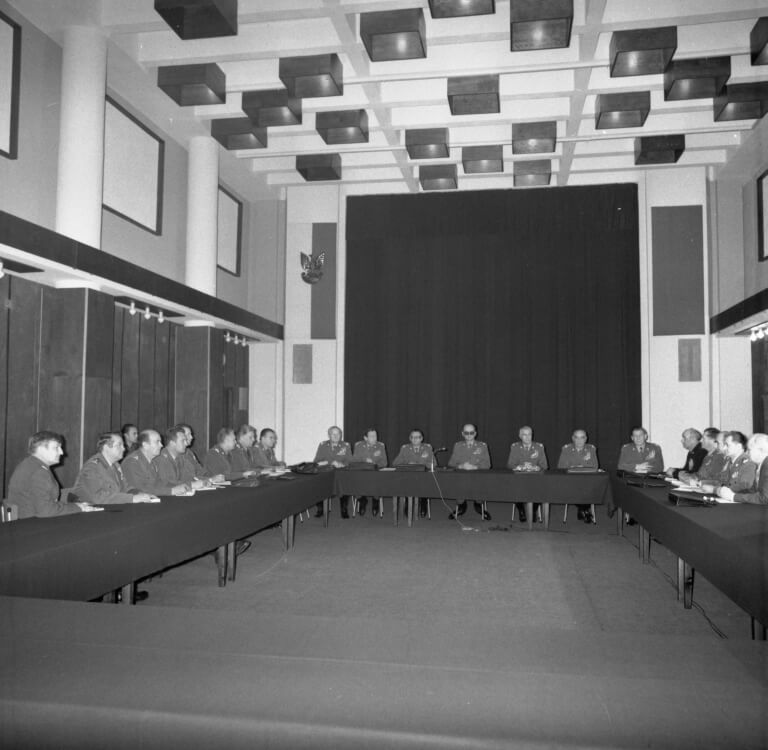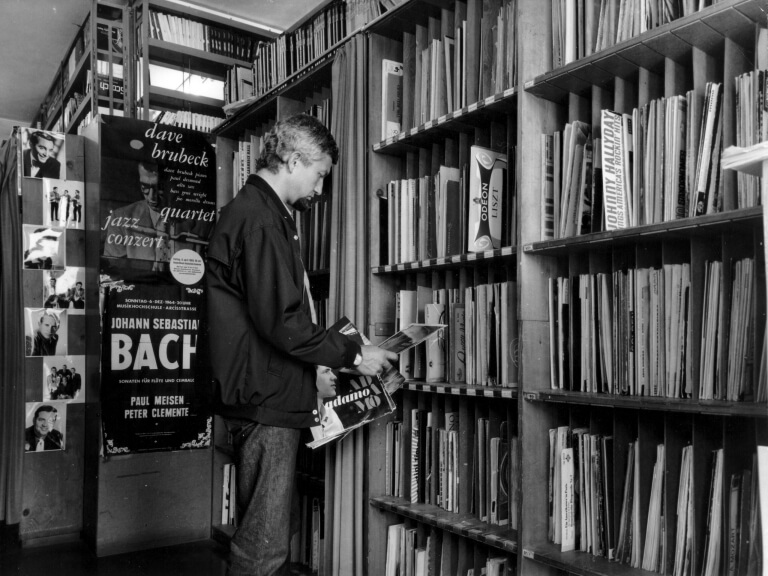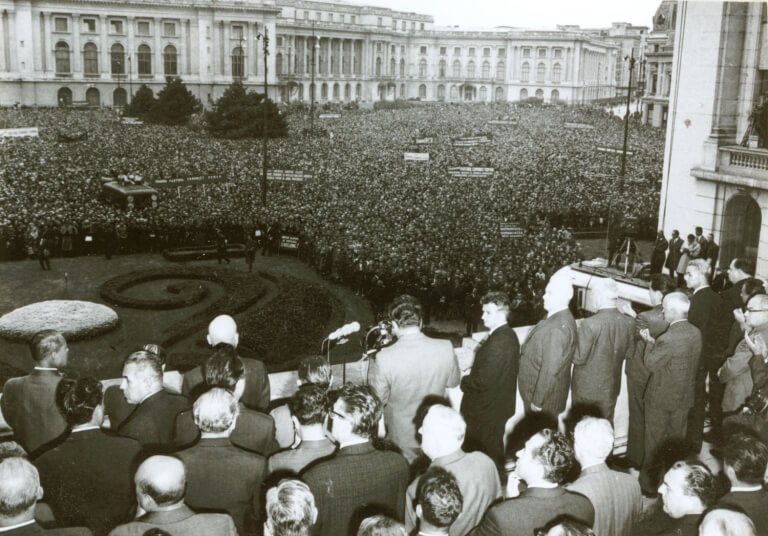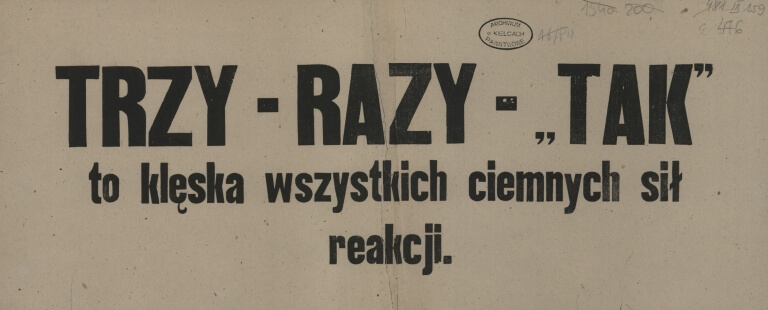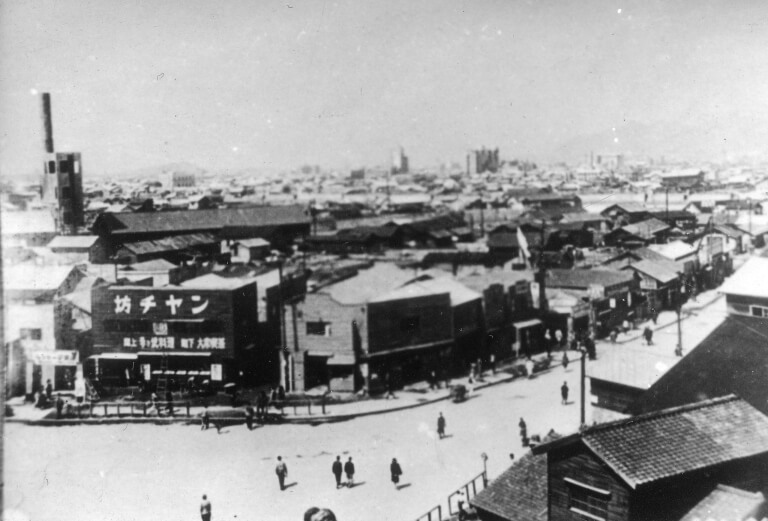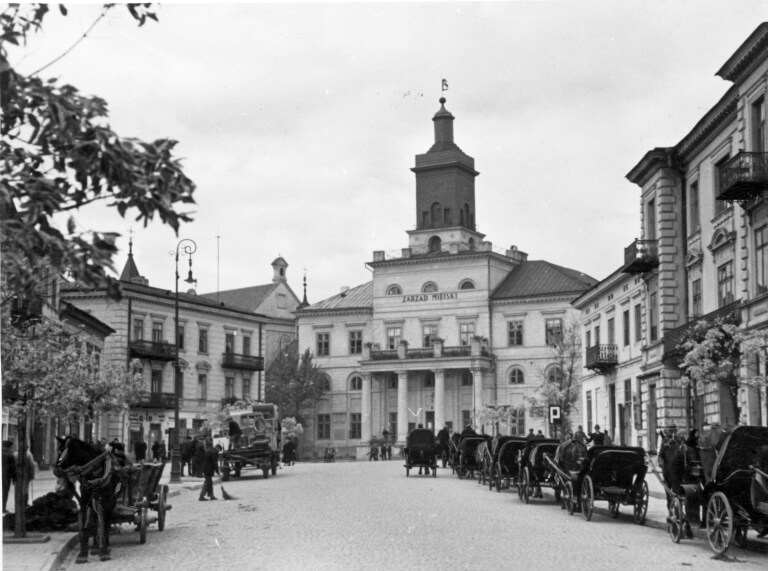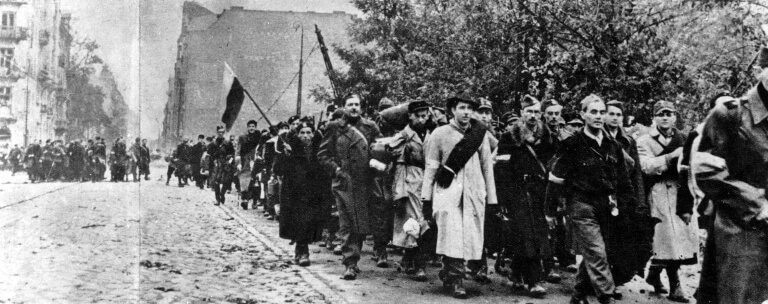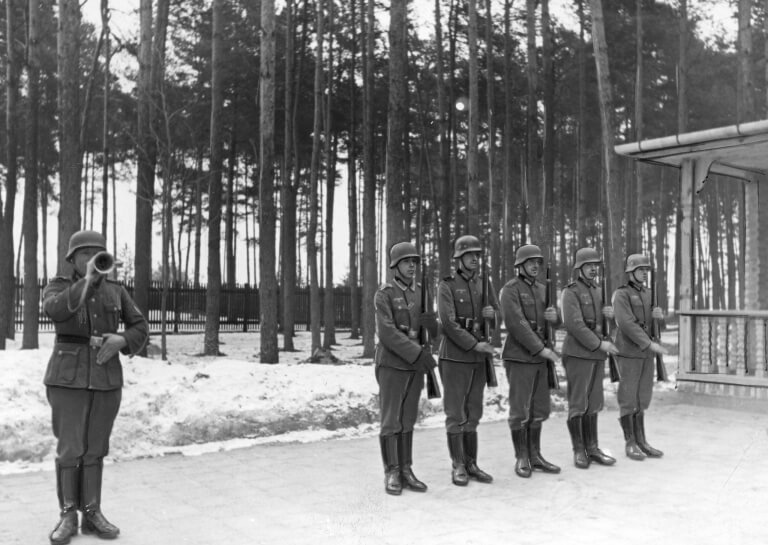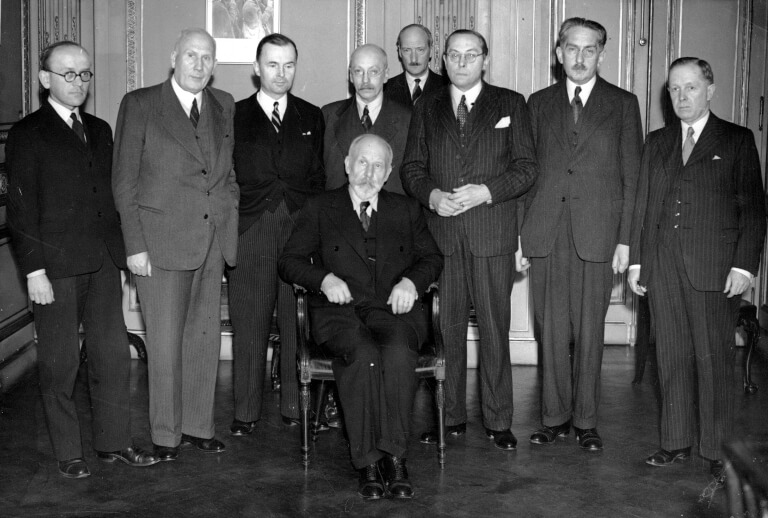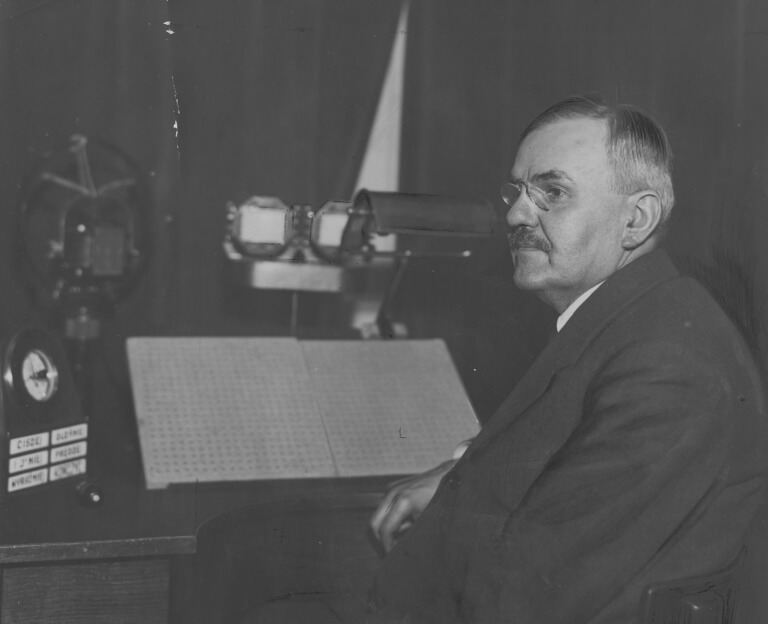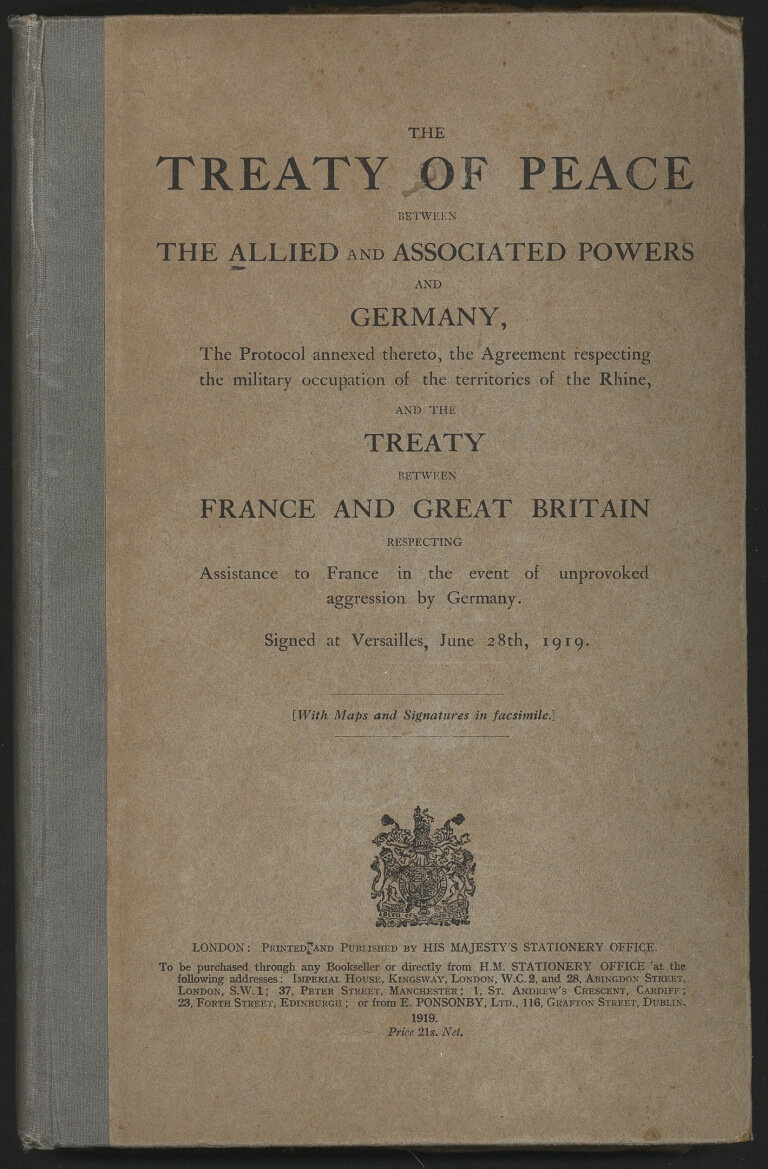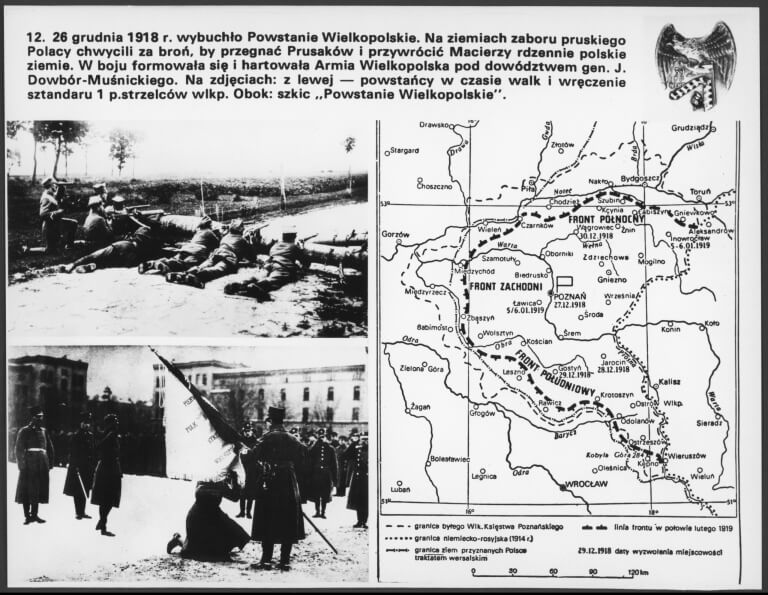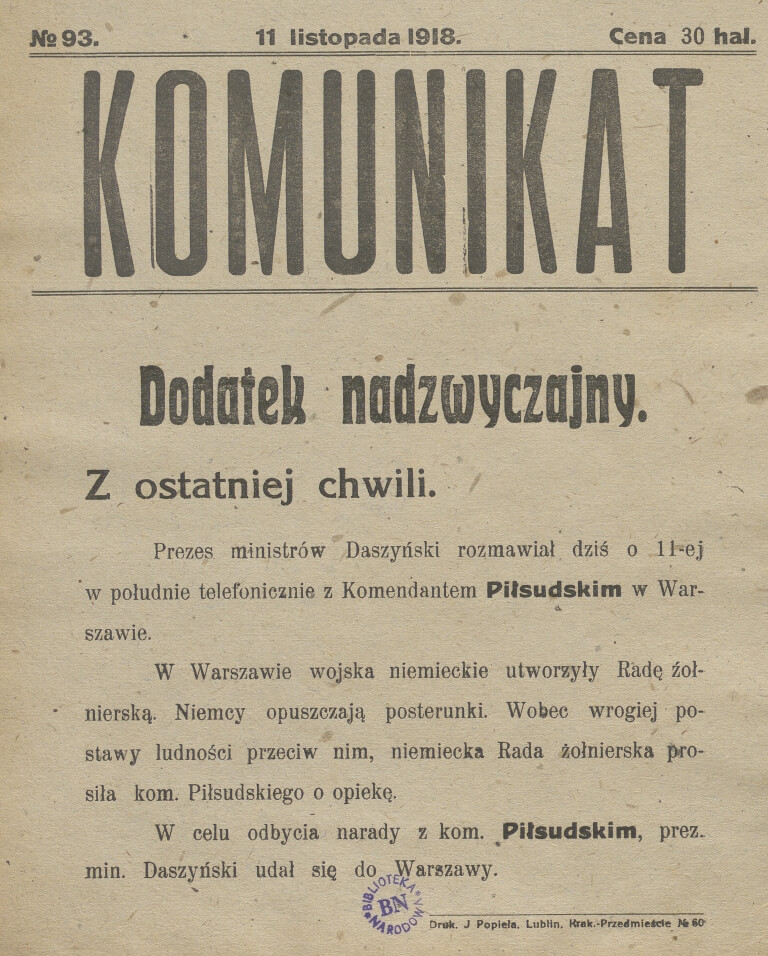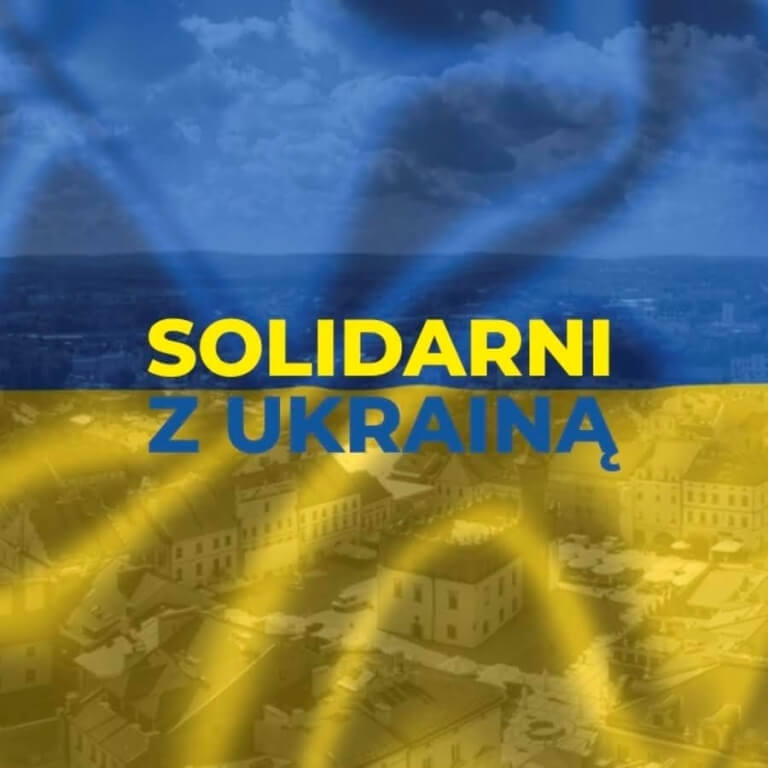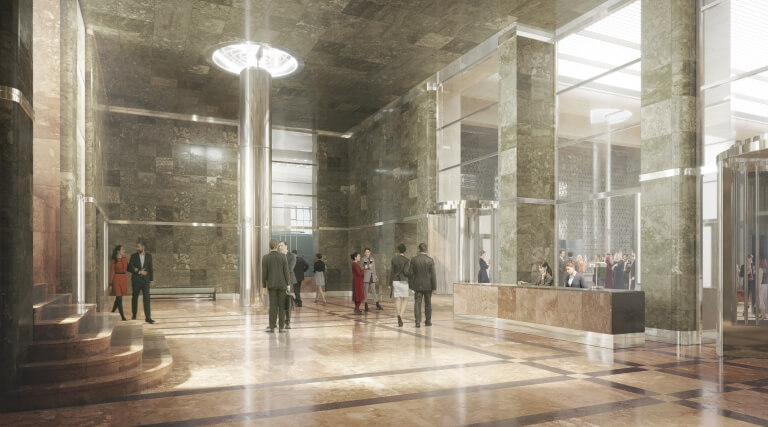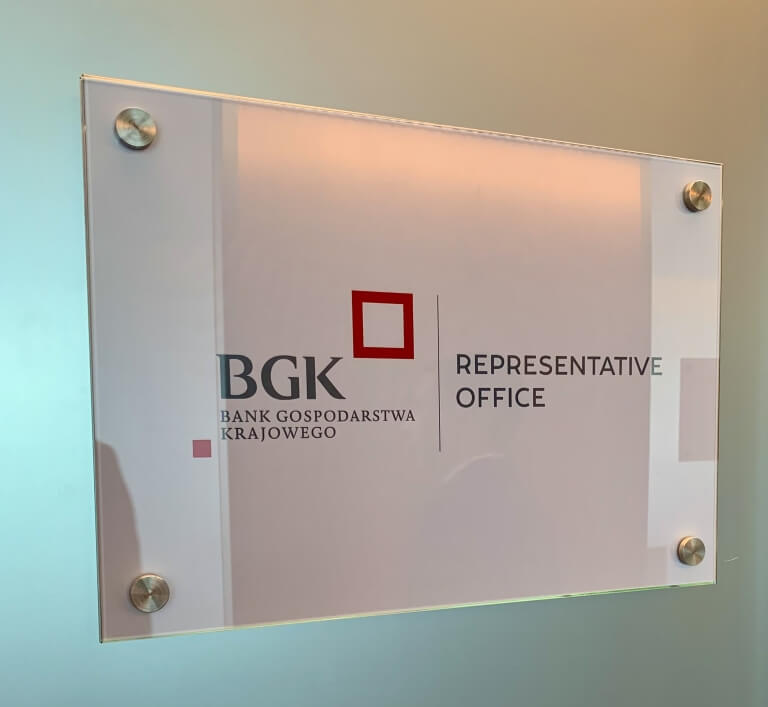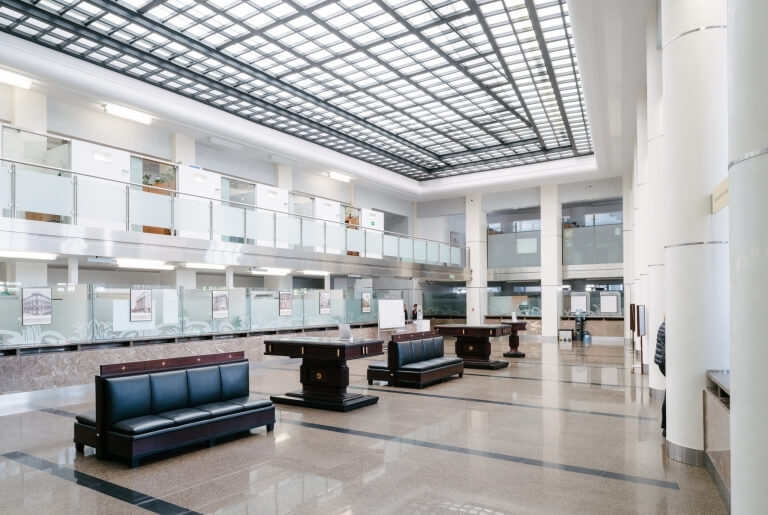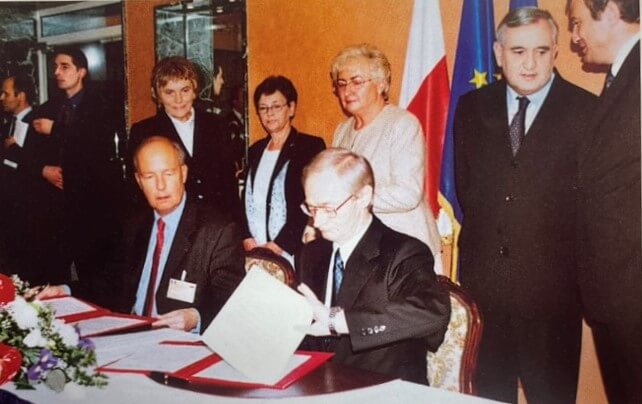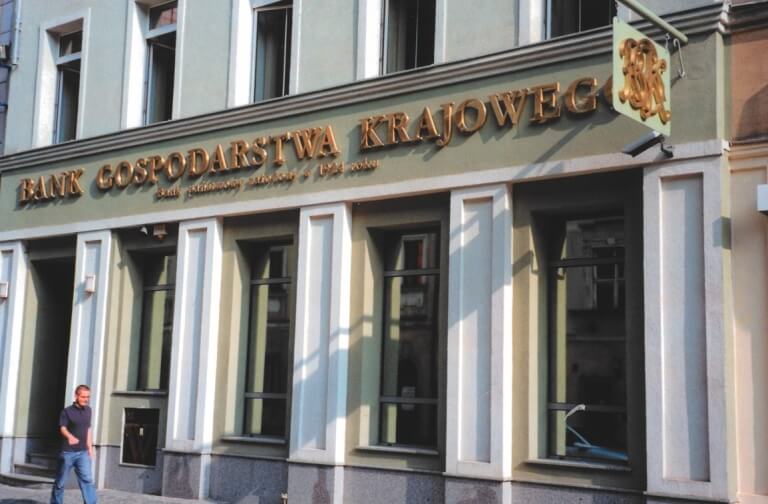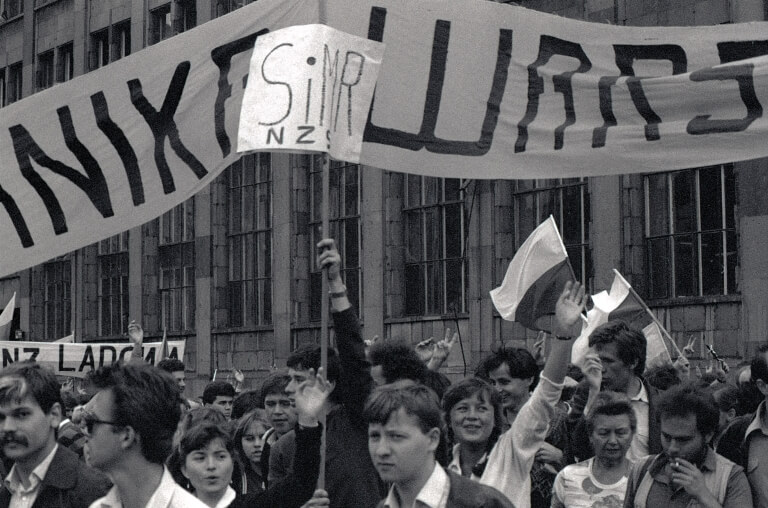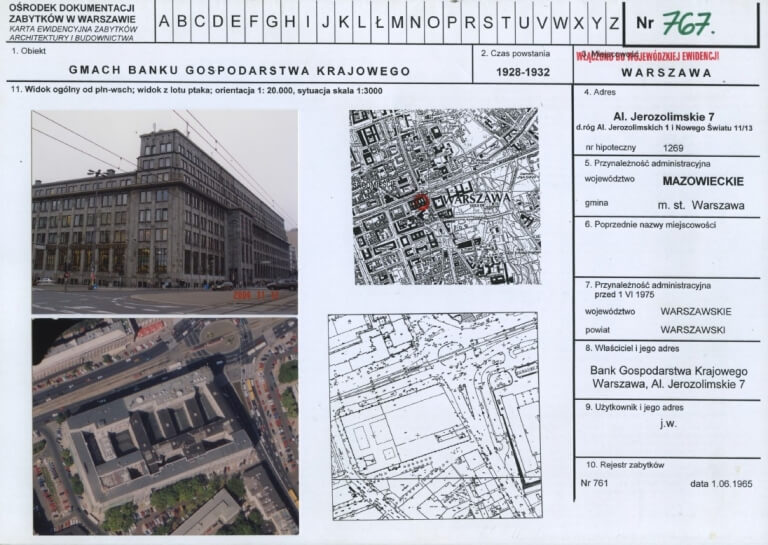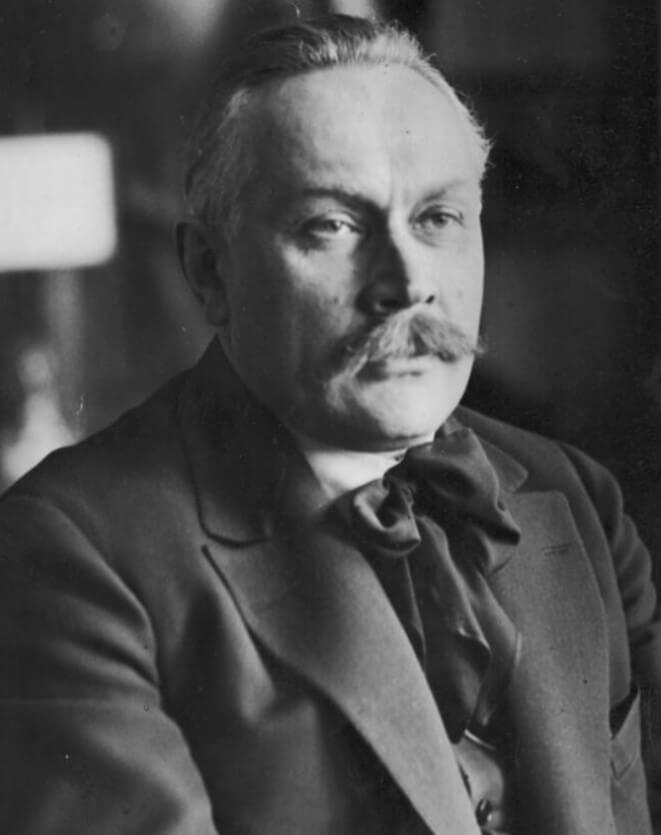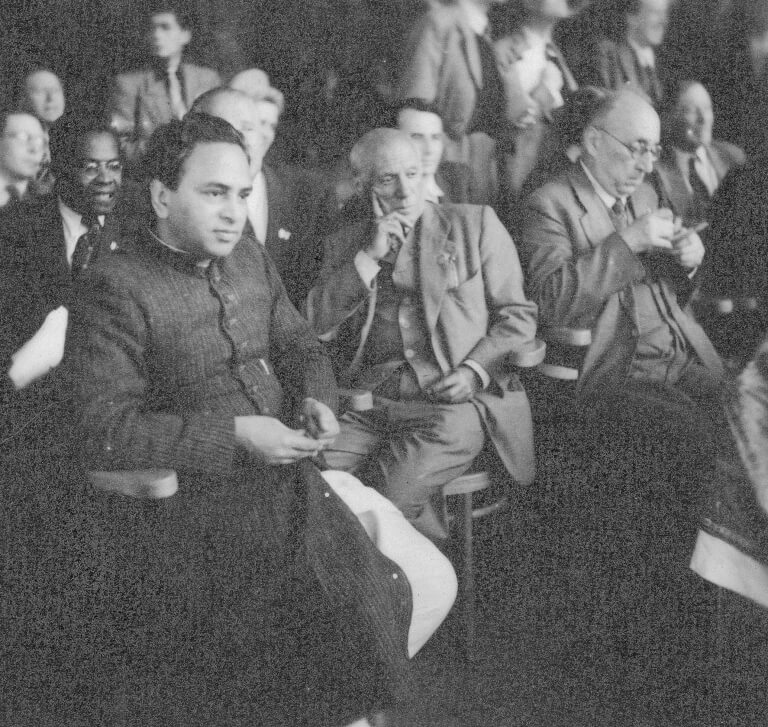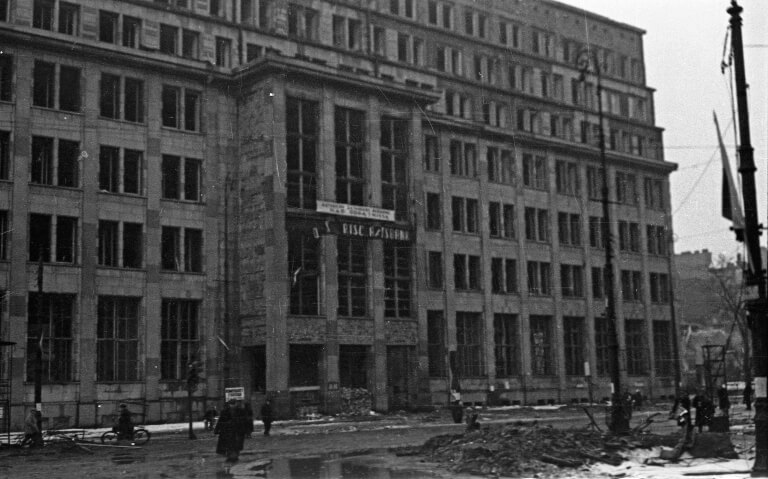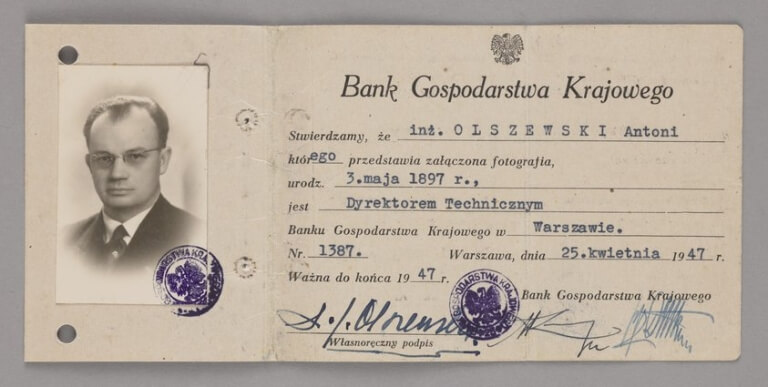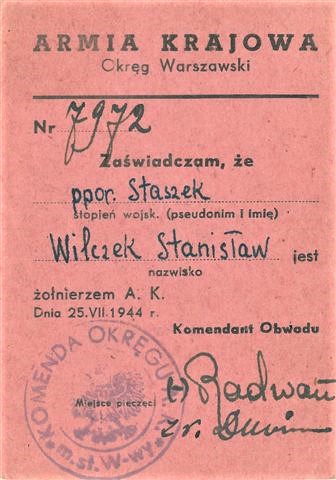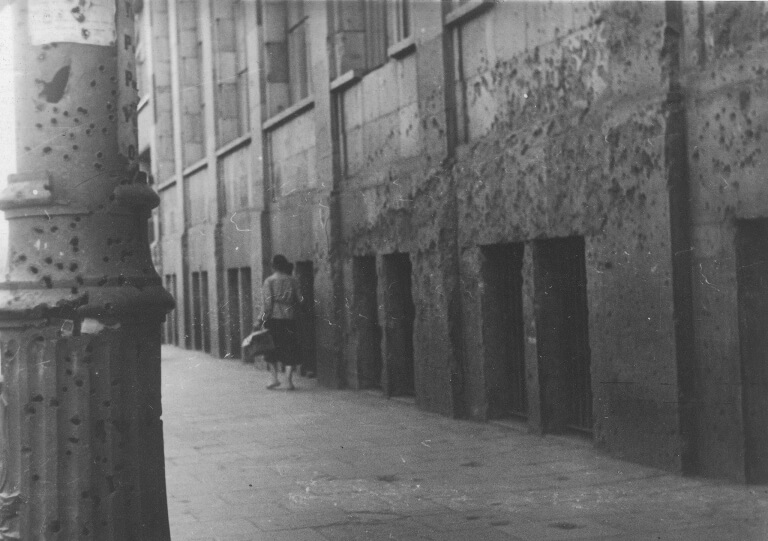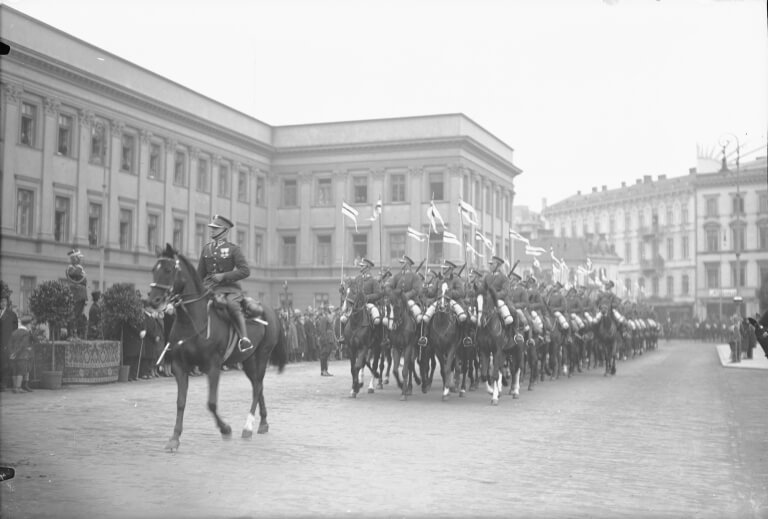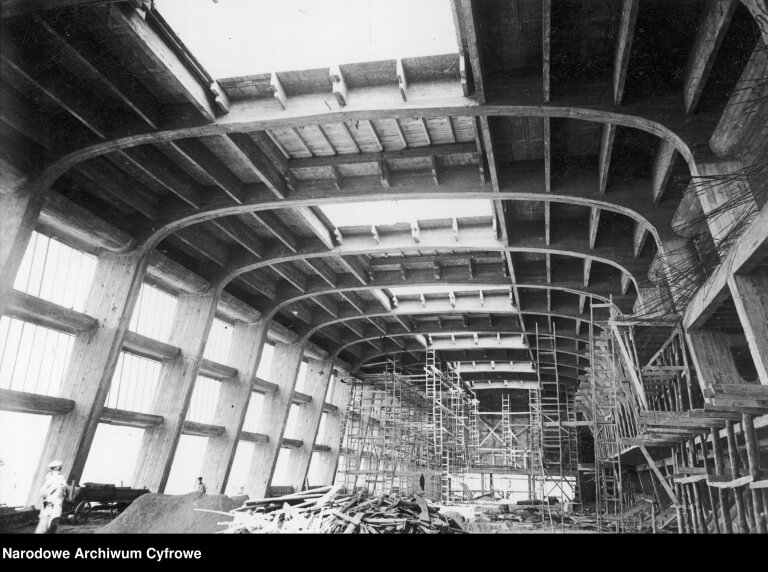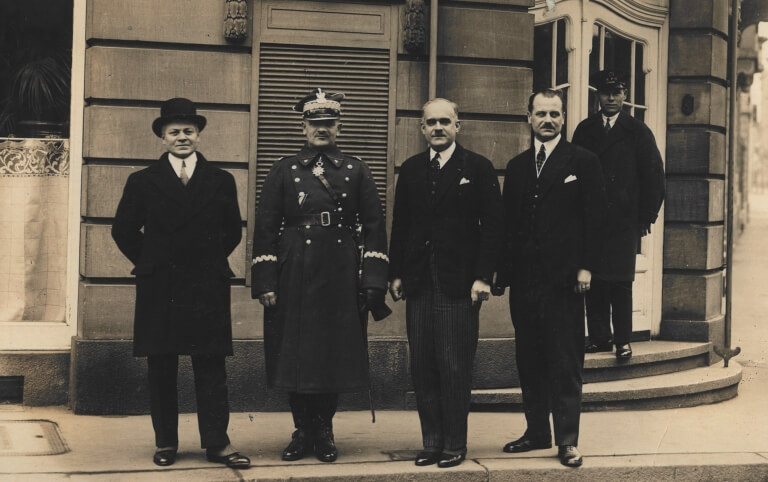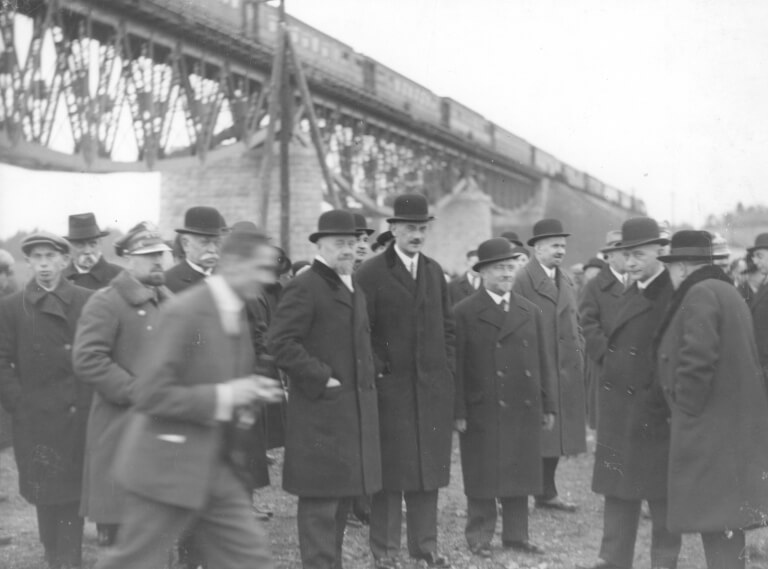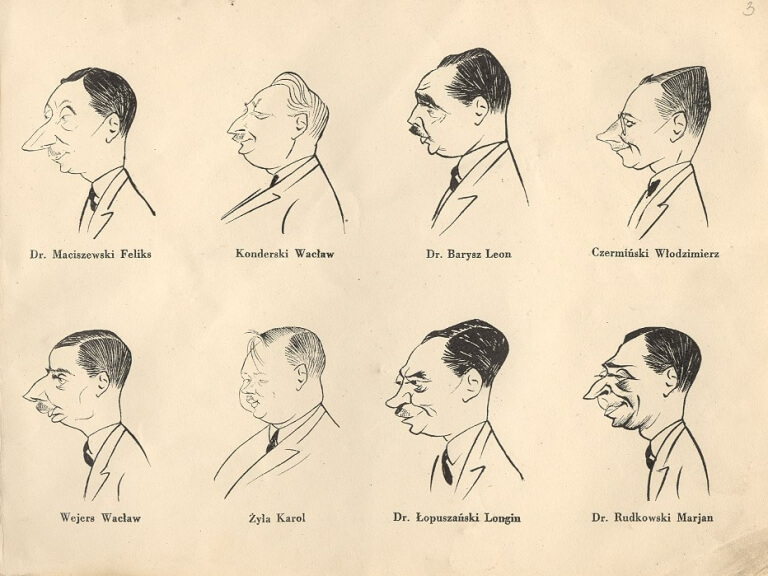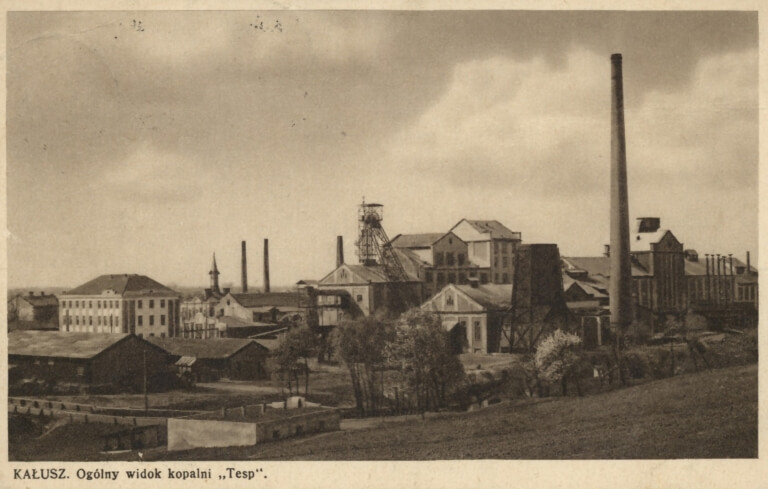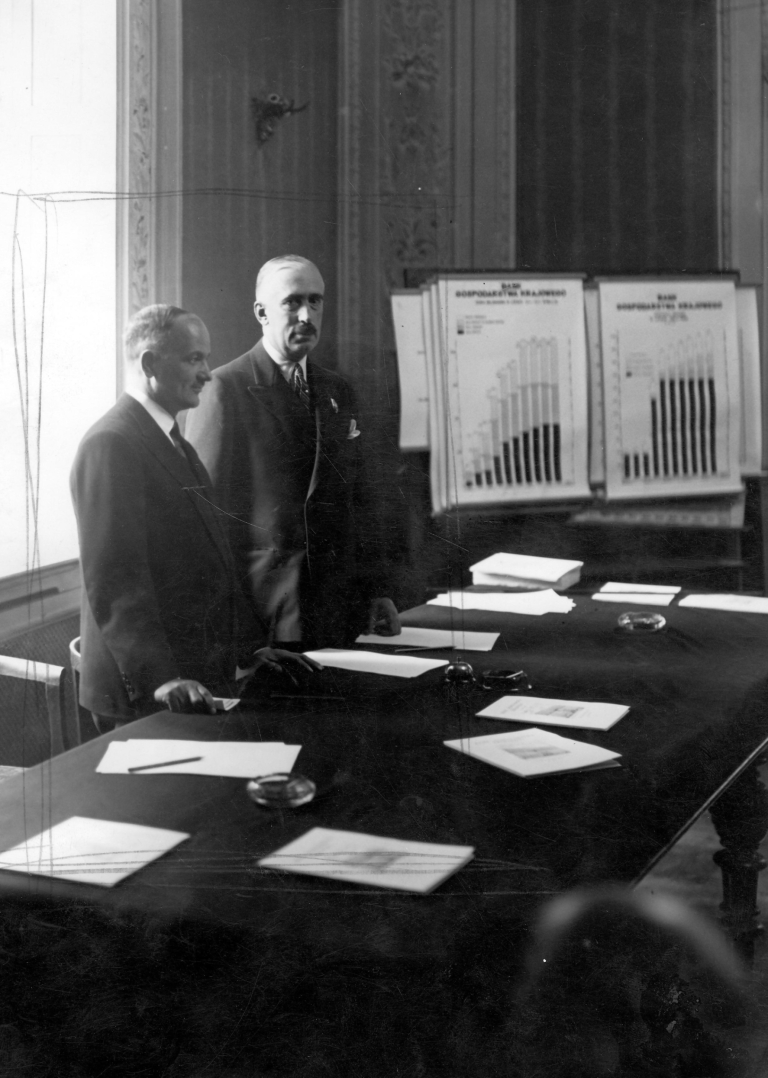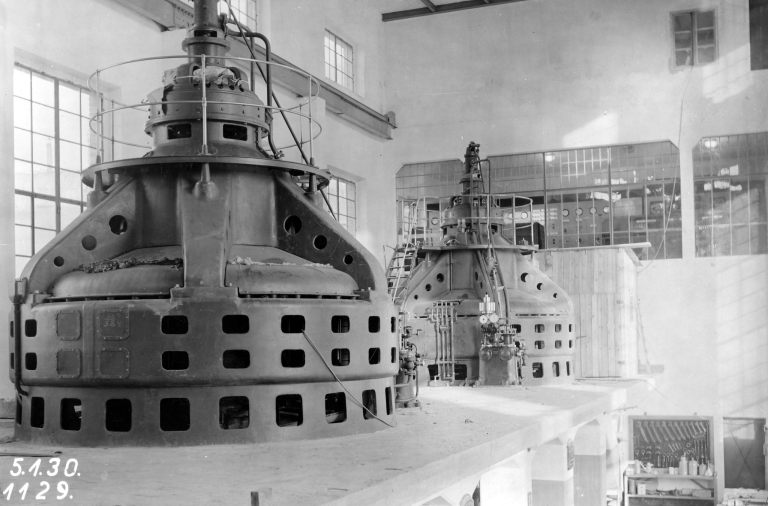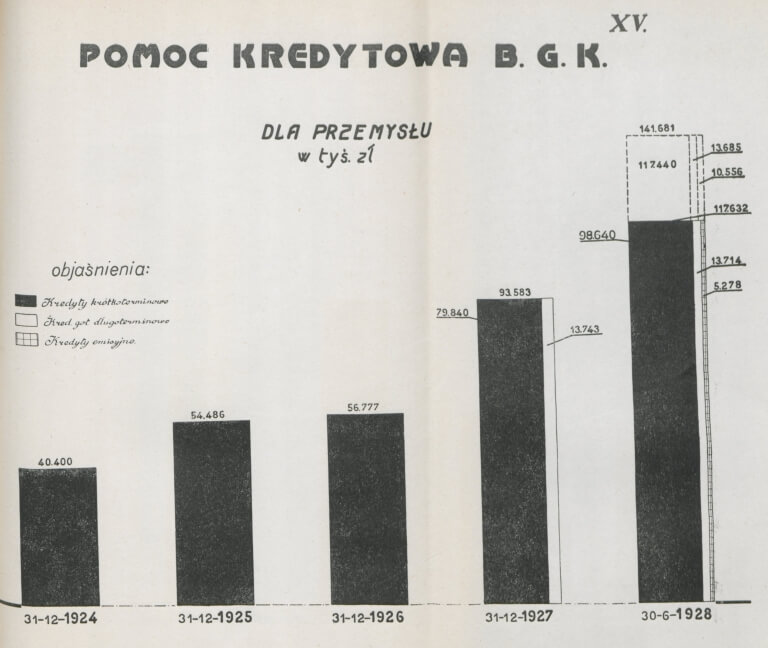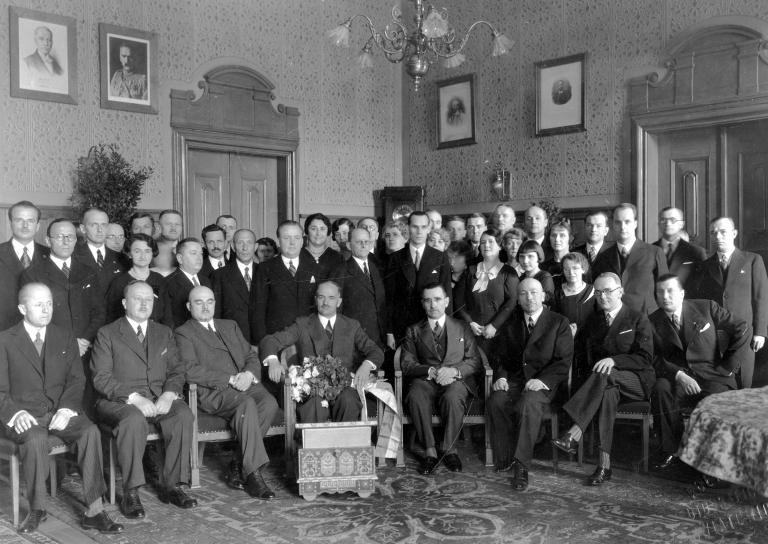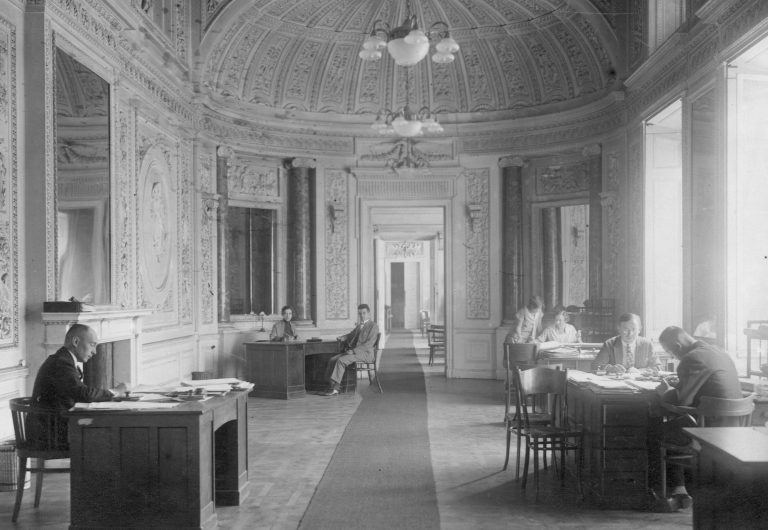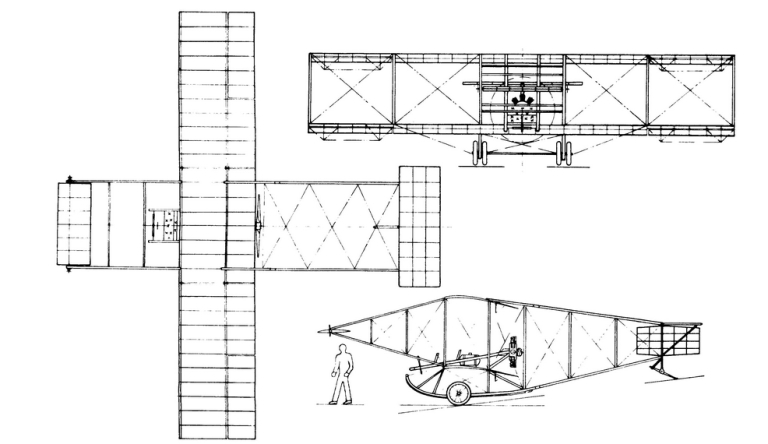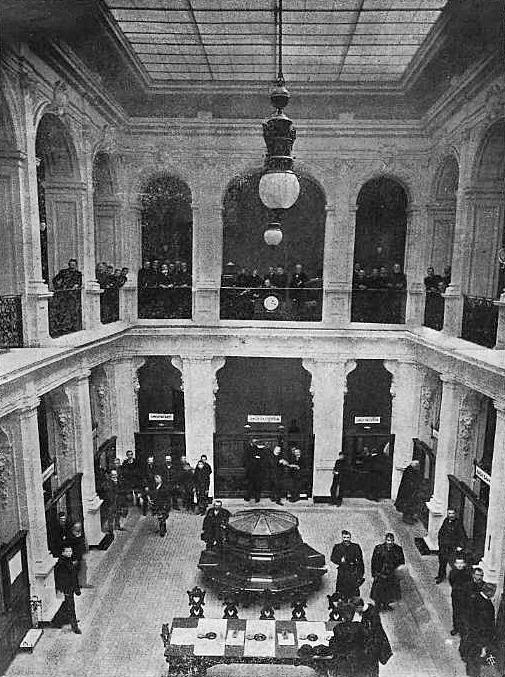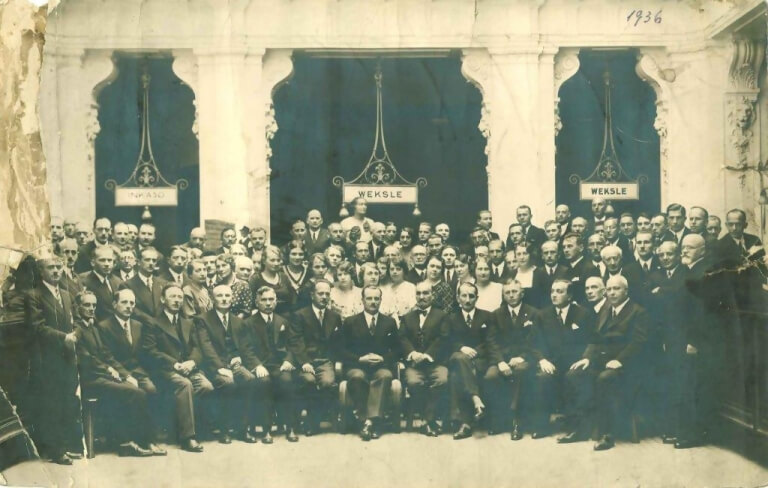Show history of:
Eugeniusz Kwiatkowski - Deputy Prime Minister, Minister of Industry and Trade of the Second Republic. He developed and managed a 4-year investment plan
Source: The National State Archives
1937
Kwiatkowski’s plan as an answer to the Great Depression
The Four-Year Plan was created to combat the effects of the Great Depression. It was developed by the entourage of the Deputy Prime Minister and Minister of the Treasury, Eugeniusz Kwiatkowski. Its aim was to bring about a lasting economic revival of the Second Republic and for the Polish state to achieve economic independence.
Photo of journalists in Poznań at the General National Exhibition.
Source: The National Digital Archives
1929
The General National Exhibition impresses with its grandeur
In 1929, Poland is the talk of the world. The General National Exhibition, held in Poznan, is visited by more than 1000 journalists and 4.5 million tourists. Everyone marvels at the transformation of Polish society, economy and culture in the span of 10 years.
“[The exhibition] bears eloquent testimony to what the Poles have achieved through strenuous work and frugality. The Poles have shown at this exhibition that there is nothing they cannot fabricate themselves. This nation is so clever that it can make anything it wants”.
„Daily Mail”
The General National Exhibition is a triumph of independent Poland, a showcase of potential and an indication of directions for further development. Industry, commerce, farmers, artists, sportspeople and Bank Gospodarstwa Krajowego presented their achievements.
2015
The beginning of the refugee crisis in Europe
The war in Syria, Lebanon and Libya; the return of the Taliban to Afghanistan or advancing climate change are just a few reasons why people in the global south are choosing to leave their homes and seek their fortunes in a richer and safer Europe. The influx of migrants to the Old Continent intensified in 2015 and continues today.
2012
UEFA Euro 2012
A draw between Poland and Greece. This was the end of the opening match of the 2012 European Football Championship played at the National Stadium in Warsaw. The tournament was hosted by Poland and Ukraine, who had been preparing for the event for a long time.
As every four years, the Old Continent was gripped by football madness. A madness that this time took place on Polish and Ukrainian streets.
At the time, 31 matches were played in eight stadiums. The title of champion went to the Spanish national team, who beat Italy in the final.
2010
Bitcoin Pizza Day!
10 000 bitcoin is now the equivalent of almost 1.5 billion zlotys. And in 2010, a programmer from Florida bought two large pizzas with cheese, olives and salami with this amount.
Laszlo Hanyecz, the man in question, got in touch with another user on the BitcoinTalk forum and offered him to exchange 10,000 units of cryptocurrency for two pizzas just for him. The latter ordered them from a local restaurant with delivery to Hanyecz’s address.
This transaction is believed to be the first documented instance where a physical good was purchased using bitcoin.
2007
A phone no one will buy
The first smartphones appeared on the market back in the 20th century. However, it was not until the launch of the iPhone – a phone with a touchscreen instead of a keyboard – that this type of device was popularised.
Today, most people cannot imagine leaving home without a small computer, giving them access to information, entertainment or a bank account. In 2007, however, experts were not enthusiastic about the new invention. Steve Ballmer, Microsoft’s chief executive at the time, even stated in an interview that “no one would buy a phone without a keyboard.”
2004
Poles moving west
The opening of western markets to workers from the Vistula has resulted in massive economic emigration of Poles.
“Visible achievements in many areas of the economy, as well as favourable changes in the living conditions of large social groups, overshadow many difficult economic and social problems. Of particular importance is the reduction of the budget and foreign trade deficits. Social tranquillity is shattered by the enormous size of unemployment and the constant threat of job losses, mainly in industries undergoing restructuring. The accumulation of these negative phenomena can be seen in Silesia and in the provinces where state-owned farms were concentrated, as well as in professional groups such as railwaymen and shipyard workers.”
Janusz Kaliński, Economist, “The Polish Economy at the Turn of the Century”, NBP 2005
The FIS Ski Jumping World Cup 2006/2006 at Holmenkollen in Oslo (Norway) won by Adam Malysz (Poland).
Source: Wikipedia
2001
Malyszomania begins
When Adam Malysz became the first Pole in history to win the Four Hills Tournament, ski jumping gained millions of fans. This love for the sport has remained with many to this day, and during competitions the red and white colours reign under the jumps.
1997
Poland under water – the Millenium Flood in the Oder and Vistula basins
Two heavy waves of rainfall that hit Poland, the Czech Republic, Slovakia, Germany and Austria in July 1997 were responsible for this tragedy. The Millennium Flood claimed 114 lives (including 56 in Poland) and caused material damage valued at almost $4.5 billion.
Water flooded around 2 600 villages – tens of thousands of buildings were destroyed and more than 160 000 people evacuated. 7 000 people lost their homes and 40 000 lost all their belongings. The cataclysm did not spare the lives of livestock either.
Many Poles joined in to help the flood victims by organising numerous charity events throughout the country.
1996
Dolly – the world’s most famous sheep
In July 1996, Dolly the sheep was born. And there would be nothing surprising about this, were it not for the fact that she was the first mammal in history to be born as a result of cloning the cells of another representative of her species. This means that Dolly was an identical copy of her predecessor. The ewe survived for seven years, giving birth to six lambs before her death.
1995
Cutting off four zeros, i.e. denomination
On the 1st of January 1995, denomination was carried out in Poland. Its requirement was to bring the galloping inflation after the economic transition under control. The denominations of the Polish currency were reduced in ratios of 1:10 000. Millions and billions went out of use. New coins and banknotes with images of kings and queens were put into circulation.
1989
“Ladies and gentlemen, on 4 June 1989 communism ended in Poland”.
“The programme (…) assumes that within four years we will make a peaceful transition from a totalitarian system to a full parliamentary democracy, from a communist economy to an economy (…) through the market (of goods, of capital), from a society mired in passivity and disillusionment to a society democratically organised and deciding its own destiny.
These transformations presuppose the achievement of at least a significant degree of state independence and are a prerequisite for the holding of free elections in four years’ time. (…) In setting ourselves up for radical transformation, we are betting on cooperation with the pro-reform wing of the PZPR. (…) We are choosing not between a good and a bad solution, but between more or less bad solutions. If the alternative to our government is the outbreak of social anger and the collapse of the process of change, it is our duty to form a government, despite everything that speaks against it.”
Jacek Kuroń in the “Polityka”, Warsaw, 29 July 1989
Jacek Kuroń, Such Persistence, selection and ed. by Maria Krawczyk, Warsaw 2011
1982
Bad things are happening in Poland
At the beginning of the 1980s. Poles had their civil rights curtailed and the country experienced an economic crisis. As a result, many citizens decided to emigrate to the West.
“The cancellation of martial law. No one is happy about it any more. General apathy and despondency. People know that nothing will change our situation any more, that the authorities have protected themselves with many laws against any attempt at democratisation. For a brief period of freedom we have taken the air for one moment. It’s worse than before, because people used to say: oh, they won’t dare to do such a thing, after all Solidarity is ten million strong! [..] And they dared.”
Teresa Lubkiewicz-Urbanowicz, writer, in her diary, Warsaw, 22 July 1983
Journal from the collection of the KARTA Centre Archive, AO II/0059/DSW
Elections to the regional authorities of the Independent Self-Governing Trade Union "Solidarity" in Przemyśl; by Jacek Szwic.
Source: The National State Archives
1980
The “Solidarity” social movement is born
“The greatness (of Solidarity – editor’s note) lay in the fact that the Poles opposed the totalitarian system of Soviet communism with a social movement of a total character, mobilising all forces striving for freedom in a kind of synthesis of national uprising and workers’ movement. This was unique and distinguished Solidarity from earlier anti-communist revolts in 1956 in Budapest and Poznan or in 1968 in Czechoslovakia. When I heard that the communist authorities had signed the August Agreements, I had no doubt that the beginning of the end of the communist system had begun.”
Professor Alain Touraine in a conversation with Edwin Bendyk, 2011
1976
Professor Lipinski shares thoughts on the country’s needs
“There is no more important issue in Poland today than gaining political sovereignty. Only political sovereignty will make it possible to carry out a consistent economic reform, such a reconstruction of the political and social system that will liberate the potential creative forces in the nation. […] No one doubts that an alliance with the Soviet Union has become a political necessity. […] We want good neighbourly relations, we want to build the foundations of mutual trust. But this is impossible before a radical cleansing of Polish policy towards the Soviet Union of elements of servility. Nor is it possible before a bold and open admission by the Soviet Union of the ‘mistakes’ committed against Poland. […]
Governance imposed by a minority always leads to totalism […] That is why an opposition is necessary in the country. A legal, equal one, in line with the principle of freedom of association and assembly guaranteed by the Constitution. Political pluralism is also expressed in the necessary freedom of the labour movement, the consumer movement, and a free press.”
Professor Edward Lipinski, President of the BGK from 1946-48, in an open letter to Edward Gierek
[„Kultura” no. 6/1976]
1975
The term global warming hits the pages of the journal “Science”
Global warming is one of the greatest challenges facing humanity today. The first signs of climate change were noticed by the scientific community almost half a century ago. The expression “global warming” was introduced into the public debate by Professor Wallace Smith Broecker, who in August 1975 published an article in the journal Science entitled “Climatic Change: Are We on the Brink of a Pronounced Global Warming?”.
1974
Gierek “overheated the economy”
“The success of all political ventures ultimately depends on the economic base. […] Loans were not expensive and banks were happy to sell them to socialist countries. […] We decided to use this opportunity to thoroughly modernise and upgrade the economy. […] Thanks to the strategic assumption of buying cheap loans in the West, we were able to plan and implement the largest investment programme in the history of Poland. […] The first symptoms of overheating occurred in 1974 […] The central planner did not take into account the social needs that resulted from the development of so many areas of the economy.”
Edward Gierek, First Secretary of the Central Committee of the PZPR, Warsaw, 1974
Janusz Rolicki, Edward Gierek, “Interrupted Decade”, Warsaw 1990
1969
You’ve got a message
In the 1960s, the US government agency, ARPA, invested in building the first network connecting computers that were geographically distant from each other. In 1969, it became possible to transmit files and emails over a distance via ARPANET – as it was referred to. This is the beginning of the Internet as we know it today.
1965
Poles are becoming poorer
“The rapid pace of investment and growth in employment increases the nominal wage fund; under conditions of production for production’s sake, the supply of objects of consumption to the market does not cover consumer demand, which entails an overpricing and threatens to reduce the real wage below the socially necessary level.”
From the “Open Letter to the Party” by Jacek Kuroń and Karol Modzelewski, Warsaw, 18 March 1965
Jacek Kuroń, “Maturing: political writings” 1964-1968, Warsaw 2009
1964
Mrozek bitterly about the future
“I wanted to say something about Poland. It is nice there, because you are always waiting there. There everything is always “building”, nothing is ever ready. There is always “tomorrow”, tomorrow there will be cars for everyone, tomorrow there will be flats, tomorrow the Polish writer expects to catch up with the Westerners, whom he consciously or subconsciously envies. […] One thing nobody realises, because it’s hard: that there will be nothing tomorrow, because tomorrow is a fraud, there is always only now.”
Slawomir Mrozek, playwright, in his diary, Chiavari (Italy), 25 May 1964
Sławomir Mrożek, “Journal”, T. 1, 1962-1969, Krakow 2010
1961
Now that’s space!
On the 12th of April 1961, at 9:07 a.m. Moscow time, the first space flight of the Vostok programme took off from the Baikonur cosmodrome in Kazakhstan. The rocket carried Yuri Gagarin into orbit, who stayed in space for 108 minutes.
“As soon as the Vostok broke through the dense layers of the atmosphere, I saw the Earth. I looked then at the sky, then at the Earth. The ridges of mountains, the great lakes were sharply drawn. Fields were visible too. The most beautiful spectacle was the horizon – as if painted with all the colours of the rainbow, a strip separating the sunlit Earth from the black sky. The convexity, the sphericity of the Earth was visible.”
Yuri Gagarin
Eight years later, on 20 July 1969, the US space mission Apollo 11 resulted in man’s first footprint on the moon.
1960
In the rhythm of Rhythm, the icons of modern design
In the 1960s, a young generation brought up after the war who wanted to live a modern life entered the industrial design studio. The change was fostered by the abandonment of socialist realism and the permission for greater creative freedom. An explosion of creativity occurred not only in design, but also in other branches of culture – music, film, visual arts and architecture.
This atmosphere transformed the design of Polish homes. Furniture designs – which had to be both aesthetically pleasing and functional – were created in line with Western European trends. This was the period when icons of Polish design were created – the 366 armchair designed by Józef Chierowski, the Ina coffee service from Ćmierlów or the colourful Rytm radio receiver produced by the Diora radio factory.
1960
A flower in the barrel of a gun – American protest movements
The 1960s was a time when the United States was flooded by a wave of social movements opposed to the established political and social order. In addition to the feminist movements and those fighting for the rights of African-Americans, which resumed their activities, there were also new ones – the hippies, the New Left student movements or the pacifist movements. American society was forever changed.
1956
Polish Thaw
At the beginning of 1956, during the 20th Congress of the CPSU, Nikita Khrushchev gave a lecture on the crimes of Stalin, who had died a few years earlier. Shortly afterwards, Bolesław Bierut died in unclear circumstances. In Poland, grassroots social movements were intensifying. In June, there was a mass uprising of workers against the communist authorities in Poznan – the demonstrations were bloodily suppressed by the army. All these events led to changes in the leadership of the ruling party. In October, Władysław Gomułka was elected as the first secretary of the PZPR.
At the time, many people hoped for the democratisation of the communist system and an end to the Stalinist period in Poland – mass terror, surveillance, the cult of the individual and the fight against the Church. Positive changes came, but not for long.
Initially, Gomulka liberalised the party’s policy towards society, but once he had consolidated himself at the top of power, he reverted to the methods used by his predecessors.
1952
The European Coal and Steel Community – the nucleus of the European Union – is established.
The European Coal and Steel Community was established by the Treaty of Paris, signed by France, Belgium, the Netherlands, Luxembourg, Italy and the Federal Republic of Germany. Its aim was to promote economic development, and thus increase employment and living standards, in its member states. This was to be achieved by the creation of a common market for coal, steel and iron. In 2009, the competences of the Community were taken over by the European Union.
1952
Polish Television broadcasts its first programme
On the 25th of October 1952, the first post-war nationwide television programme was broadcast at 7pm. A 30-minute montage of art forms was then broadcast. This moment is considered the beginning of Polish Television. On the 5th of December 1952, the first sports programme was broadcast on Polish television. These were show sabre fights.
1950
Poles are developing the country, despite the government hindering them from doing so
“The period of the 3-year plan [1947-49] was long enough for an evaluation of the economic activity of the communist government. By any economic standards, this examination comes out negatively. The Warsaw government did nothing to facilitate the efforts of society in the work of rebuilding the country.
It received minimal credit in its relations with foreign countries. The advertised aid from Soviet Russia was in fact an economic exploitation of Poland. […]
Within the interior, nothing has been neglected to hinder the public at every turn. Small industries […] are being openly destroyed. […] In the field of agriculture, apart from the provision of the planned amount of fertilisers, no economic strokes can be seen to facilitate agricultural production. […]
Indeed, if one separates from the activities of the economic authorities in Poland the day-to-day administration carried out in the same or better way in other European countries, and wishes to look for the moves that brought the country economic success, one will not find such moves. […] The reconstruction of Poland after 1945 is a triumph and a credit to Polish society. Against all obstacles and economic harassment, this society did not fail.”
Wacław Micuta, Member of the UN Economic Commission for Europe
“‘Kultura”, Paris, no. 12/1950
Speeches by Konstanty Dabrowski during the autumn session of the Polish Sejm.
Source: The National State Archives
1948
Treasury minister urges economic efficiency
“Money and credit in the socialist economy take on a new meaning, being not only a means of financing the tasks of the Socialist State, but at the same time becoming a powerful means of exercising control over the entire economy, a means of educating, forcing people to be thrifty, to maintain the principles of thrift.”
Konstanty Dąbrowski, Minister of the Treasury, at the Unification Congress of the PPR and PPS, Warsaw, 19 December 1948
Aleksander Władysław Zawadzki, “An Outline of the History of the Ministry of Finance in the Years 1944-1975 and the Organisational State of the Ministry in 1975”, Warsaw 1978
Propaganda poster: "In unity and work we will prevail in the struggle for peace".
Source: The National State Archives
1946
Economy on the Soviet model
Shortly after the end of the war, Poland introduced a centrally planned economy – following the Soviet model. There was a nationalisation of industry, agriculture and other market sectors.
“For the purpose of the planned reconstruction of the national economy, to ensure the economic sovereignty of the State and to increase the general welfare, the State shall take over the ownership of enterprises under the terms of this Act. […]
The State shall take ownership, with compensation, of: mining and industrial enterprises in the following branches of the national economy: [among others] […] the large and medium-sized textile industry.”
From the Act on the Acquisition of Basic Branches of the National Economy into State Ownership, “Dziennik Ustaw Rzeczypospolitej Polskiej” No. 3/1946, Warsaw, 3 January 1946
1945
Reconstruction of the capital begins
“The enormity of the damage to Polish towns and cities after the Second World War calls for a prudent approach, based on the experience of previous years. […] The owner of a property will immediately set to work on rebuilding it in the desire to save himself from further losses, extracting the remnants of his own financial resources. The same thing would be done under the pressure of necessity by a citizen who does not have his own dwelling or who owns a dwelling that is not usable. For the need to have one’s own dwelling is as natural and understandable as the need to satisfy hunger or to have one’s own clothes. […]
It would, however, be a mistake to think that by proceeding in the same way as before the war, satisfactory results could be achieved immediately. It must not be forgotten that, as a result of the perturbations of the war, fundamental changes have taken place in economic life. Private capital in Poland has been largely destroyed, and the population of Warsaw in particular has become almost completely impoverished. Therefore (…) the possibility of attracting it [private capital] to work in the construction industry to a greater extent in the first post-war years is not to be reckoned with. Public capital must therefore be mobilised in the largest possible amounts, and not only to play the role of an incentive for private capital, but simply to bear almost the entire burden of the first reconstruction.”
Zdzisław Łysakowski, Director of the Main Branch of the BGK in Warsaw, in a study on the reconstruction of the capital city
1944
PKWN issues decree on land reform
In September 1944. The Polish Committee of National Liberation {PKWN) issued a decree on carrying out land reform, which established the State Land Fund. This one took over from the owners all agricultural properties exceeding 50 hectares (in some provinces – 100 hectares), as well as all those which belonged to citizens of the Third Reich, Polish citizens of German nationality and to persons convicted of high treason. The PFZ also seized land that had belonged to the state treasury before the outbreak of the Second World War. In addition to the land, it took back livestock and all buildings with their furnishings (including manors).
The acquired estates were partly divided among the peasants and partly taken over by the state. Those who received land in this way were expected to repay it over a period of between 10 and 20 years by providing quotas of rye or its equivalent in cash.
Daily life in one of the Polish Army camps in the USSR - dispensing bread.
Source: The National State Archives
1942
Increasing terror
“Today marks three years since the start of the war. The last year has been much harder than the previous ones. The terror intensifies more and more and, despite one’s will, one wonders if one can stand it.”
From the diary of Zygmunt Klukowski, Szczebrzeszyn, 1 September 1942
Formation of the first mass transport of prisoners to Auschwitz concentration camp at the train station in Tarnow.
Source: Wikipedia
1939
The occupying forces carrying out operations of destruction (Action AB) and deportations to Siberia
The Extraordinary Pacification Action (German: Außerordentliche Befriedungsaktion – AB) was carried out in the General Government and was genocidal in nature. During this action, the Germans murdered at least 6.5 thousand Poles, more than half of whom were Polish intellectual and political elites.
In the winter of 1940, the NKVD carried out the first mass deportation of Poles to Siberia. Many, of the 140,000 deported, died en route. The deportees were mainly people living in the eastern areas of Poland, including families of military officers, civil servants, railway and forestry workers.
1939
The people react to the outbreak of war
The disaster is unquestionable and immeasurable, and immeasurable is its extent, the complete disintegration of the population and the army. There is no front and no rear, there is danger from everywhere, there is nowhere to go, because what is here is everywhere. Not only those men who were ordered to leave Warsaw, but every soldier and officer is looking in vain for a place where they will be received, organised, dressed, armed and fed.
From the diary of Zofia Nałkowska, Jeleniec (Lubelskie Voivodeship),
15 September 1939.
Speech by Deputy Prime Minister and Minister of the Treasury Eugeniusz Kwiatkowski.
Source: The National Digital Archives
1937
In the forks of Vistula and San establishment of Central Industrial District
On the 5th of February 1937, at the request of Deputy Prime Minister and Minister of the Treasury Eugeniusz Kwiatkowski, the Sejm adopted a plan for the construction of the Central Industrial District. Situated at the junction of the Vistula and San rivers, the CID was one of the largest economic investments in interwar Poland.
“Just as the word Gdynia once became the entire economic programme, so today we are putting a new slogan on the industrialisation programme, which is given the symbolic and abbreviated name of the “central district” – Sandomierz. Today, this district between the San and the Vistula is a greater programme-economic void than the Eastern Borderlands. Today, it is neither eminently agricultural nor industrial, it has no economic physiognomy, although in moments of danger it would have to become a centre of organised material defence. (…)
Economically, the district must become a bridge that creates an outlet both for agricultural produce from the eastern districts and for raw materials and semi-finished products from the western districts. (…)”.
„Dzień Dobry”, Warsaw, No 37/1937
1932
“Enigma” no longer so enigmatic
At the end of December of 1932, Polish mathematicians Marian Rejewski, Jerzy Różycki and Henryk Zygalski broke the code of the ‘Enigma’ cipher machine. The latter was used by the German armed forces. The significance of this event is significant – to this day many historians claim that if the Allies had not understood the information sent by the ‘Enigma’, World War II would have lasted 2-3 years longer.
1929
Black Thursday marks the beginning of the greatest crisis in the history of capitalism
On Thursday, 24 October 1929, the New York Stock Exchange saw a sharp collapse in share prices. A few days later, it became clear that the situation was uncontrollable. In just two days (28 and 29 October), 30 billion dollars evaporated from the market. This in turn triggered a wave of bankruptcies, production and employment cuts and cost-cutting. The global economic system collapsed.
At the time, for the average person this was a completely incomprehensible phenomenon. After all, nothing alarming had happened – no war had broken out, no cataclysm had struck, the world was not facing a major crop failure….
And yet. The Great Depression lasted until 1933 when – thanks to the intervention of government bodies – production returned to normal in many countries.
However, some phenomena could no longer be reversed. Rising unemployment and the massive impoverishment of the population during the crisis meant that in countries such as Germany and Italy, social unrest was on the rise and support for extreme political groups was increasing.
Installation of cranes at the harbour cooling tower. The "Long Henry" floating crane is visible.
Source: The National Digital Archives
1926
From now on, Gdynia will be a city. And a port city at that!
After Poland regained independence, it did not have its own seaport even though it was the sixth largest country in Europe. To change this, in 1920 the government decided to build a port in a small settlement, which Gdynia was at the time. In a dozen or so years, this fishing village of 1,300 people turned into a modern city with 130,000 inhabitants. On 4 March 1926 Gdynia was granted city rights, and in 1934 it was the most modern reloading port in Europe.
“[In Gdynia] the boundary of cooperation with the nations of the whole world converges. (…) Each new ship, each new factory on the Coast, each bank (…) is a great gain, a serious asset of our national heritage”.
From a speech by Eugeniusz Kwiatkowski, Minister of Industry and Trade
1926
Hello, hello, Polish Radio Warsaw, wave 480
The first radio broadcast in Poland began on 18 April 1926, at 5 p.m. The words “Hello, hello Polish Radio Warsaw, wave 480”, reached the ears of listeners. Just 13 years later, in 1939, the radio boasted one million subscribers.
1925
Germany suspends Polish coal imports
On 1 July 1925, a Polish-German customs war broke out, which lasted nine years. The pretext was coal, but the stakes were much higher – whether it would succeed in destabilising the young Polish state and forcing it to revise its borders.
1924
Bank Polski SA enters the financial map of the country
As a result of Władysław Grabski’s reforms, Bank Polski SA began operating in Warsaw on 28 April 1924. The institution gained the exclusive right to issue bank tickets, which were legal tender in the country.
“The Government is convinced that, through its own efforts and those of society as a whole, it will soon succeed in overcoming the financial crisis long awaited by the nation. This goal can be achieved by a great increase in the payment powers of society, by the reduction of many even urgent needs and by strenuous work and savings in all fields and spheres. Austerity must be applied not only in the state economy, but also in the private economy. A measure of civic worth in any modern state is also to pay taxes honestly, to be truthful in declaring one’s wealth and to pay one’s dues to the treasury at the appointed times, to invest one’s savings at home and not in foreign currencies or abroad. When everyone has done their duty, normal times will soon follow.”
The Government in its Proclamation to the Citizens of the Republic of Poland
Warsaw, 27 January 1924
1923
Inflation? 35,714 percent!
Inflation had shot up! Although the rate had remained high since the end of the war, in 1923 it reached as high as 35,714 percent. Prices skyrocketed and savings were losing value not even overnight, but hour by hour.
1922
President Gabriel Narutowicz is assassinated
When the National Assembly elected Gabriel Narutowicz as the first President of Poland, a festival of hatred began both in the press and on the streets of Warsaw. Political opponents stressed that Narutowicz had won the vote thanks to the support of national minorities, while he had won fewer ‘Polish votes’ than the right-wing candidate for the post, Count Maurycy Zamoyski.
Gabriel Narutowicz himself was a renowned engineer in the field of hydraulic engineering, who “returned to Poland in 1920 to take up a ministerial portfolio at a salary less than that he was reportedly paying his servant in Switzerland.”
On the 16th of December 1922, the newly elected President visited the Zachęta building, where he attended the opening of an exhibition of paintings. As he admired the winter landscape depicted in the painting Frost, three quick shots were fired at him by Eligiusz Niewiadomski. These, unfortunately, proved not only accurate but also fatal.
“This all lasted for a second, and then I looked at the President and noticed that he was looking at me with puzzled eyes and wobbling. (…) he fell on top of me inertly. We pulled him to the couch, but it was too short, so we had to put him on the floor. His eyes were open, he stared at us and slowly, silently faded away.”
Jan Skotnicki, “By the Easel and at the Desk. Memories, Warsaw 1957
1921
Poland’s strength in agriculture
In the early 1920s, 60.3 percent of Poles were engaged in agriculture. At that time, the figure was 5 percent in England, 21 percent in Germany and 35 percent in Czechoslovakia. 92 percent of all women were employed in agriculture.
Polish-Soviet war - parade encouraging people to join the army
Source: The National Digital Archives
1920
Independence has a price
The first years of independence were very expensive for Poland. In 1919, more than 60 percent of the state budget was consumed by military expenditure and the war with Bolshevik Russia. Inflation was killing the already ruined economy.
1918
The end of the First World War
In autumn of 1918, a new country, Poland, was born from the rubble of the Great War. However, the country was devastated. Within four years, more than three million Poles were called up for military service. They fought in the partitioning armies. Foreign armies pillaged factories. Homes were short of copper pots, which were melted down for weapons. In Warsaw, wooden fences were torn down for firewood.
As a result of the First World War, industrial production in the Polish territories fell by 86 percent and agricultural production by more than 30 percent. 90% of railways were destroyed.
Socially and economically, the Polish-Lithuanian Commonwealth was then strongly differentiated. The Russian partition accounted for 69 per cent of the country’s area, – 20 percent was Austrian, 11 percent was Prussian. In terms of development, Upper Silesia was several generations ahead of the then-poor Polesie.
The most pressing economic challenges facing the young state were the elimination of war damage, securing capital for investment and modernising industrialisation.
2020
Britain leaves the European Union
In a referendum held on June 23, 2016, the people of the British Isles voted in favor of Brexit, i.e. Britain’s departure from the structures of the European Union. The process was long and complicated – it took as long as three and a half years. In the end, after tough negotiations, Britain left the European Union on January 31, 2020.
2013
Euromaidan – Ukrainians (once again) take to the streets
On November 21, 2013. Ukrainians protested against Viktor Yanukovych for the second time (after the Orange Revolution in 2004). This time the nation was brought to the streets by Yanukovych’s decision not to sign an association agreement with the European Union. With each passing day, the conflict grew, and the attitudes of the population radicalized.
Although protests were held throughout the country, the movement became known as “Euromaidan”, as it was Independence Square (“Maidan Nezalezhnosti”) in Kiev that was the site of continuous demonstration rallies.
An attempt to violently suppress the demonstrations led to the deaths of more than a hundred people. Eventually, Viktor Yanukovych decided to hold early elections and left the capital. On February 22, 2014, he was removed from office, and the Ukrainian parliament appointed Oleksandr Turchynov in his place.
1993
O joy, bright spark of divinity – the European Union is being formed
The beginning of the long-standing process of political, economic and social integration of Western European countries dates back to the post-war period. In 1952, the European Coal and Steel Community was established. Six years later, the European Economic Community was established, of which the European Union is the direct successor.
The community was established on November 1, 1993, under the Maastricht Treaty, which was signed by six European countries – Germany, France, Italy, the Netherlands, Belgium and Luxembourg.
"Solidarity" parade and rally in the Przemyśl market square during the May Day celebrations; by: A. Baranowski
Source: State Archives in Przemyśl
1989
The political and economic transformation of the country
As a result of the partially free elections held on June 4 and 18, 1989. The Solidarity Civic Committee received the maximum number of seats allowed in the parliament. Two months later, Tadeusz Mazowiecki’s government was formed.
“The government I will form is not responsible for the mortgage it inherits. It does, however, affect the circumstances under which we operate. We will cross out the past with a thick line. We will only be responsible for what we have done to bring Poland out of its current state of collapse. I am aware that the most important question for my compatriots today is whether things can get better. We will all answer it. (…) We must do it together.”
Tadeusz Mazowiecki, Prime Minister of the Republic of Poland in a speech at the Sejm, Warsaw, August 24, 1989
Leszek Biernacki, “Chronicle of Solidarity. 20 years day by day…”, Sopot 2000
1989
Opposition debates with authorities at the Round Table
The Round Table Talks are one of the most important events in recent Polish history. They were negotiations conducted between the authorities of the People’s Republic of Poland and representatives of the opposition and the Catholic and Evangelical Augsburg Churches.
The talks covered issues of union pluralism, the economy, social policy and political reform.
The negotiating parties have reached an agreement, as a result of which it was agreed that the opposition will be able to take part in the upcoming elections to the Diet and Senate.
“At that time, the Solidarity side obtained the maximum of what was possible. At that time, there was no other solution but to compromise with those in power. The Round Table meeting was necessary. It was a link in the chain of the nation’s struggle against communism. Communism would probably have ended anyway, only much later and perhaps also bloodily.”
Lech Walesa, “The Road to Truth. Autobiography”
Demonstrations of December 1970 in Gdynia: Zbyszek Godlewski's body carried by demonstrators
Source: Wikipedia
1970
Massacre on the Coast
In mid-December 1970, a week and a half before Christmas, the communist authorities of the People’s Republic of Poland decided to raise the centrally determined prices of basic foodstuffs. Sometimes even by several dozen percent. In response to this decision, workers there took to the streets of Gdansk, Gdynia, Elblag and Szczecin. Their protests were bloodily suppressed by the Polish army and police.
The most tragic day of events on the coast was 17 December, later called Black Thursday. It was then in Gdynia that the army opened fire on shipyard workers going to work.
According to official figures, 45 people were killed and more than a thousand injured during December 1970.
“Firecrackers are roaring, gases are falling
Shots are being fired at the workers
Old people, children, women are falling
Janek Wisniewski fell
One wounded, the other killed
Blood is spilled in the December dawn
It’s the party shooting at the workers
Janek Wisniewski fell
(…)
Shipyard workers of Gdynia, shipyard workers of Gdansk
Go home, the fight is over
The world has learned, nothing has been said
Janek Wisniewski fell
Do not cry mothers, it’s not for nothing
Above the shipyard banner with a black bow
For bread and freedom and a new Poland
Janek Wisniewski fell”
Krzysztof Dowgiałło, excerpt from “The Ballad of Janek Wiśniewski”
1956
Society is still “choking on the vapour of Moscow”
“The fever of the Polish October Revolution seems to have left us all. We are now taking a sober look at everything. And what does it turn out to be? Just as before we were sitting in a sealed wagon, suffocating in the vapour of Moscow – so we are. I’d say we’ve just knocked ourselves out with a piece of planking and had a bit of clean air blowing over us. Those who couldn’t see but felt it started shouting: hurray! They thought it was a whole door opening and they were free to go out. They soon found out that it was only one plank that had been knocked out and everything was as it was, you still had to stand in the carriage. Those who stood further away made an unnecessary shout. [Where are the changes? […] I look diligently around, I listen, I read and really – what is there to be happy about?”
From an anonymous letter to Polskie Radio, Radom, 2 November 1956
“Book of letters PRL”, T. 2, 1956-1970, Warsaw 2005
1947
Under pressure from the USSR, Poland refuses to participate in the Marshall Plan
The Marshall Plan was a programme to rebuild Europe’s economy after the Second World War. It was implemented between 1948 and 1952, during which time the United States provided European countries with loans (often forgiven) to the tune of around $17 billion. Unfortunately, under pressure from the USSR, Poland rejected the offer to participate in this venture.
1946
The propagandists encourage: “‘Three times YES’.
On 30 June 1946, a so-called people’s referendum was held in Poland. In it, citizens were to decide on the existence of a senate, the consolidation of economic changes resulting from the agrarian reform and the western borders of the country. Propagandists encouraged a positive answer to all three questions, for which reason the referendum was called “3 x YES”.
“Do not give obedience to the disturbers and breakers of national unity! By answering “yes” three times, confirm those results of the reconstruction of the country, which were achieved by the Government of National Unity, thanks to the hard sacrificial work of millions of Poles. By answering ‘yes’ three times, lay the foundations for the development of Poland as a country without unemployment, without poverty and darkness, as a country of peace, freedom, order and prosperity.”
Edward Osóbka-Morawski, Prime Minister of the Government of National Unity, Warsaw, 30 June 1946
“Życie Warszawy” No 178/1946
“The revolution is imposed and dictated by Russia, with the help of its agents. These agents, whatever we call them – party, government – often quarrel among themselves, fight each other, but they agree on one thing: they will not allow anyone into co-government, by means of parliamentary elections, by means of local government, through institutions and private enterprise.”
Karol Estreicher, art historian in his diary, Cracow, 30 July 1946
Karol Estreicher, Journal of Accidents, vol. 1, Cracow 2001
1946
The Iron Curtain has been drawn in Europe
“This is not the liberated Europe we fought for. Nor is it the Europe of lasting peace. (…) From Stettin in the Baltic to Trieste in the Adriatic an iron curtain has fallen across the continent. Behind this line lay all the capitals of the old Central and Eastern European states – Warsaw, Berlin, Prague, Vienna, Budapest, Belgrade, Bucharest, Sofia.”
Winston Churchill, in a speech at Westminster College, Fulton, 5 March 1946
1944
The outbreak of the Warsaw Uprising
“Soldiers of the Capital! Today I have given the order longed for by you to fight openly against the everlasting enemy of Poland, the German invader. After nearly five years of uninterrupted and hard fighting, carried out in the underground conspiracy, you are standing today, armed to restore Freedom to your Homeland and to mete out exemplary punishment to the German criminals for the terror and crimes committed on Polish lands.”
Gen. Tadeusz Bór-Komorowski, commander of the Home Army, in an order, Warsaw, 1 August 1944
1941
Germany conducts aggression against the Soviet Union
“The attack on the Soviet Union began on 22 June 1941. Hitler was again going from victory to victory. Again, the horror of reaching paraffin and then strengthening his ability to continue the war was gripping us.”
Feliks Młynarski, Krakow, 22 June 1941
Government in exile - Minister Waclaw Komarnicki in the centre.
Source: The National Digital Archives
1939
A government in exile
Following the aggression of the Third Reich and the USSR against Poland, in order to avoid captivity and being forced to capitulate, the country’s authorities decided to emigrate. The first seat of the government operating outside the borders of the Republic was Paris. Later – Angers and London. Until 1945, these authorities were internationally recognised as the only legal government of Poland. Although the authorities lost this status after the end of the war, the government continued its activities until Poland’s first general presidential election in 1990.
1939
World War II breaks out
In May 1939. Jozef Beck, then Minister of Foreign Affairs, responded strongly to Germany’s aggressive demands on Poland during a parliamentary speech.
“Peace is a precious and desirable thing. Our generation, bloodied in wars, certainly deserves peace. But peace, like almost all things in this world, has a high but measurable price. We in Poland do not know the concept of peace at any price. There is only one thing in the lives of people, nations and states that is priceless. That thing is honour.”
Józef Beck, Warsaw, 5 May 1939
Less than four months later, on 1 September 1939 at 4:40 a.m., the German air force began the bombardment of Wieluń. As a result, over 1,200 people were killed and the city centre was 90% destroyed. The attack marked the beginning of the military operations of the Second World War.
Władysław Grabski - Professor of political economy, Rector of the Warsaw University of Life Sciences.
Source: The National Digital Archives
1924
Grabski’s reforms as a remedy for hyperinflation
The reforms of Władysław Grabski (then Prime Minister and earlier Treasury Minister) were aimed at combating rampant hyperinflation. As part of the changes introduced, it was forbidden to finance the budget deficit with credit drawn from the Polish National Loan Fund. Bank Polski SA was also established, and the zloty became the legal tender in the Republic.
Grabski’s reforms brought the desired effect. They were carried out with internal capital – Poland did not borrow from foreign institutions for this purpose, which limited political pressure that could lead to a revision of the country’s western borders.
Manifestation in Warsaw. Deputy Speaker of the Sejm Stanislaw Tsar leaves the stand
Source: The National Digital Archive
1922
The crisis of democracy in Europe
The Treaty of Versailles was supposed to provide Europe with a period of long peace. However, social tensions began to rise on the Old Continent just a few years after the resolutions reached in Paris were announced.
In April 1922, a German-Soviet treaty was signed at Rapallo, breaking the political isolation of the two European powers. Six months later, Benito Mussolini, leader of the Fascist movement, came to power in Italy.
In Germany, the 1920s saw the beginnings of the NSDAP, the Munich putsch and Adolf Hitler’s formulation of the Nazi movement’s programme.
In the eastern reaches of Europe, Joseph Stalin seized power in the Russian Communist Party (Bolsheviks) after the death of Vladimir Lenin in 1924, following a political showdown with Lev Trotsky.
1919
The Polish-Bolshevik war breaks out
Between 1919 and 1921, the war between the Second Commonwealth and the Russian Federative Soviet Socialist Republic was underway. The aim of the latter was to transform European countries into Soviet republics, in which the ideology and political doctrine of the Russian Communist Party would apply. The wave of Bolshevism pouring towards the West already met resistance on the territory of the reborn Poland.
1919
Treaty of Versailles
On the 28th of June 1919, the peace treaty ending the First World War was signed in the Hall of Mirrors of the Palace of Versailles. The document established new European states and revised the borders of existing ones. A number of provisions also applied to defeated Germany, which was demilitarised, was to surrender some of its territories to neighbouring countries and pay reparations to countries that had suffered losses as a result of its military actions.
Roman Dmowski and Ignacy Paderewski put their signatures on the document on behalf of Poland.
“Never, as in that room, did one feel the historical solemnity of the moment, more solemn for us Poles than for anyone else. On the table lay the text of the treaty to be signed by Germany, a treaty which recognises an independent Polish state (…).”
Roman Dmowski, “Polish Politics and the Restoration of the State”
Insurgents during the fighting and the presentation of a banner to the 1st Wielkopolska Rifle Regiment;
Source: State Archives in Przemyśl
1918
Greater Poland uprising
At the end of 1918. Poles from the Province of Poznan rose up in arms against the Weimar Republic, demanding that the lands they inhabited be annexed to the recently reborn Poland. The Greater Poland Uprising broke out in Poznan, where Ignacy Paderewski gave a speech to his compatriots in front of the Bazar Hotel on 26 December 1918. The following day, armed German soldiers arrived in the city – marching through the streets of Poznań, they attacked Polish institutions and tore down the flags of Poland and its coalition partners. Riots ensued, which escalated into an armed struggle.
“As darkness fell, German soldiers began firing from the direction of the Police Presidium. The Germans set up two machine guns here, and amidst the general panic of the bewildered population, they began firing in the direction of the “Bazaar”, including at the windows where Paderewski lives, bedridden from the Spanish shipwreck (…). At first, there was no response from the Polish side, as they tried to come to some agreement and avoid bloodshed. However, when the shooting continued and a number of people were wounded, the People’s Guard began to respond to the shots and ordered security measures to protect passers-by (…)”
“Kurier Poznański”, no. 298, 29.12.1918.
The uprising ended on the 16th of February 1919. An extension of the armistice between the Weimar Republic and the Entente states was then signed in Trier – the insurgent army was recognised as an allied army.
1918
Poland regains its independence
Independence, dreamt of by generations of freedom fighters, in 1918 allows for the rebirth of Poland as a state. In the following years, however, the Republic would have to confront democratic practice and economic reality. Moreover, the Polish society of 1918 was nothing like that of 1795, when the Polish-Lithuanian state was disappearing from the map of Europe. The time when Poles did not have their own state coincided with the industrial revolution and the birth of capitalism, and at the same time huge changes in the social structure – occupational, cultural and class. The three different legal, educational and social systems also needed to be unified and harmonised.
1914
Assassination of Archduke Franz Ferdinand Habsburg
On 28 June 1914, Archduke Franz Ferdinand Habsburg, who was visiting Bosnia, disembarked with his wife, Sophie, at the railway station in Sarajevo. The couple directed their steps towards the dark grey Gräf & Stift car in which they were to travel to the city hall. In one of the narrow streets of the capital, a Serbian nationalist, Gavrilo Princip, fired several shots at the princely couple, killing them both.
This event was the direct cause of the outbreak of the First World War, a conflict that claimed millions of lives and completely changed the boundaries on the political map of Europe.
Carnokozince in Russia and Novosiolka in Galicia - general view of neglected hen houses in Carnokozince and wealthy brick houses in Novosiolka. In the background, the ruins of a castle are visible on the left, a windmill on the right.
Source: The National Digital Archives
1867
Galician Autonomy
Until the 1860s, Galicia was a province of the Austrian Empire. However, after 1960, the Poles made efforts to give it political and cultural autonomy. As a result of a settlement with the Austrian government, Galicia managed to obtain such rights as the introduction of the Polish language as an official language and the appointment of a Minister for Galicia.
It is in Galicia, and the Polish credit institutions operating there, that Bank Gospodarstwa Krajowego has its roots.
2022
A helping hand for Ukraine
“Ukraine’s GDP has shrunk by about a third, and material losses related to infrastructure damage alone exceed $100 billion. The international community should do everything to help Ukraine win the war. At the same time, Bank Gospodarstwa Krajowego together with the European Commission and KredoBank will support Ukrainian companies especially in the agricultural, industrial and agri-food production sectors. Assistance will be in all places in Ukraine, even the most dangerous ones, where bombs can fall any day.”
Beata Daszyńska-Muzyczka, President of BGK
2021
Water, hydrogen and carbon, or the 3W Concept
The aim of the project is to support the world of science and business in the development of modern technologies used in industry, energy and medicine. Three resources – water, hydrogen and coal – properly used will change the Polish economy into a more innovative and competitive one.
“For Bank Gospodarstwa Krajowego, providing financial services is not enough. In the first phase of the hydrogen power industry, BGK also wants to be an initiator, integrator and educator. To this end, the Bank has set up the “3W Initiative,” an acronym for three resources: water, hydrogen and coal used outside the energy sector. The goal is to bring together the worlds of science, business, public administration, as well as financial institutions and NGOs into an ecosystem that supports the development of modern technologies. BGK will, of course, also financially support well-designed hydrogen projects, especially at the stage of their commercialization and implementation.”
Łukasz Beresiński, Director of the Fuel and Infrastructure Sector Office at BGK
https://www.pb.pl/wodor-to-przyszlosc-nie-tylko-energetyki-1136868
The COVID - 19 pandemic has left its mark on the economy
2020
BGK supports the crisis shield for entrepreneurs
“It is now crucial to provide entrepreneurs with quick and easy access to external financing. Guarantee programs, including guarantees financed by the Intelligent Development Program, are very helpful in providing support to companies. Taking out a working capital loan with the new Biznesmax guarantee is the fastest and easiest way to provide the funds necessary to settle current obligations (…). For those entrepreneurs who, for various reasons, cannot use bank financing, we have prepared, also in cooperation with BGK, liquidity loans. We assume that already at the end of April this product will also be available to companies.”
Małgorzata Jarosińska-Jedynak, Minister for Funds and Regional Policy, Warsaw, 14 April 2020
2020
Moving to the Varso skyscraper. But only temporarily
The bank leased five floors in the 91-meter tower for the modernization of its historic headquarters on Jerozolimskie Avenue. This will be the first comprehensive renovation since the building was built in 1931, and will restore its former design and splendor.
“Only the facade of the building was refreshed in 2011. (…) “We want to combine historical architecture with a modern and functional arrangement of space. Since the first floor and the first and second floors are under the protection of the conservation officer, we will coordinate the new arrangement with him. The plan is that after five years we will return to the renovated edifice in Jerozolimskie Avenue. (…)
At the same time, we applied to the Mazovian Provincial Conservator of Monuments in Warsaw to grant our building the status of a Monument of History. This is a form of monument protection in Poland, granted to immovable monuments of particular cultural, scientific and artistic value to the cultural heritage of our country.”
Anna Czyż, spokeswoman for BGK, Warsaw, 22 July 2019
2018
To support culture, is to support the development of the country
“And culture and the creative industries represent an intangible but extremely important value for any country. We look at many countries today through the prism of architecture, painting, music – in short, national heritage. It’s hard to talk about this in terms of economic, tangible profits, but it builds each country’s brand and needs to be supported. Such an instrument is therefore extremely necessary. Here we are fulfilling BGK’s mission of supporting the country’s socio-economic development.”
Beata Daszyńska-Muzyczka, President of BGK
Thanks to the Creative Europe program, BGK loan guarantees could benefit companies involved in design, film art or computer game production, as well as publishers, art galleries, organizations involved in extracurricular forms of art education, and many others.
2018
Trilateral Fund to propel Central Europe
“EU funds have made a major contribution to leveling out the backwardness of Western European countries. However, one can still see gaps where capital is needed. There are many projects that are shelved because they are too small, not strategic, because other projects are more important for the moment. There are examples of investments waiting to be implemented for several years at a time. (…)
The assumption is that through the fund’s support of investments in the areas of infrastructure, energy and the digital economy, the competitiveness of the region as a whole will be raised. We are dealing with a Europe of different speeds, and the idea is to create a one-speed EU. This means that Central Europe should accelerate.”
Beata Daszyńska-Muzyczka, President of BGK
https://forsal.pl/artykuly/1253798,fundusz-trojmorza-wzmocni-potencjal-gospodarczy-regionu.html
2016
BGK wants to be “wherever Polish businesses are, or can be.”
“The [BGK] foreign representation in Brussels will, among other things, support the foreign expansion of Polish companies in the Benelux countries. We are already with our entrepreneurs in 60 countries on six continents. We also cooperate with the Polish Investment and Trade Agency.
In addition, in Brussels we want to represent the bank in contacts with EU and financial institutions, monitor legislative processes and cooperate with other development banks and associations present in Brussels.
We act like other development banks, which have representative offices around the world. Such a presence builds recognition in the financial market and the credibility of Poland’s financial sector. And thanks to this, foreign financial institutions trust our entrepreneurs more (…) We plan to have more representative offices wherever there is, or can be, a Polish business.”
Beata Daszyńska-Muzyczka, President of BGK
2013
BGK’s de minimis guarantees and sureties save failing companies
“In response to the economic downturn, the government has prepared a program of guarantees for micro, small and medium-sized entrepreneurs to secure loans for current operations. For a total amount of up to PLN 50 billion! They will be granted by Bank Gospodarstwa Krajowego through commercial banks.”
From information on the Bankier.pl website
The de minimis guarantee program was an instrument of state intervention, which assumed part of the risk associated with the loans. In the first year of the guarantees and warranties, entrepreneurs were able to use them at no cost to them.
2010
Time to freshen up a bit – renovation of the facade of the historic BGK headquarters
The work was carried out under the supervision of an expert from the Ministry of Culture and National Heritage and the capital’s conservator of historical monuments.
“Traces of history were left on the facade – indentations in the stone from World War II rifle bullets. (…) Some of the stone elements that had previously been concreted over were also reconstructed. Also washed (with water alone) was the risalit with reliefs, protruding in front of the facade from Jerozolimskie Avenue, which – supported by four rectangular pillars – emphasizes the main entrance to the building.”
From information on the Onet website
[https://wiadomosci.onet.pl/warszawa/koniec-remontu-elewacji-zabytkowego-budynku/x2erssj]
2002
Handling of European funds
“We always had to reign in the fact that the debt states were agreed upon. (…) Any stumble could have serious consequences for Poland in general (…). The payments were really big, and the biggest one (…) we made for early debt repayment to Germany (…) of 1 billion 431 million euros. It seems hard to imagine, but the execution of such a payment we had to organize well in advance – to warn our partners abroad that we would be transferring such large funds. I (…) had a good relationship at Deutsche Bank, and we practically monitored all the time (…), however, to ensure the security of the implementation of this task.”
Krzysztof Śliwka, employee of the Department of Transport Infrastructure Financing at BGK, Warsaw Recording from 25 November 2021
1998
A branch of BGK in Wroclaw is being established. It is to bring aid to flood victims
After the catastrophic flood in July 1997, those affected needed funds for repairs and reconstruction. Bank Gospodarstwa Krajowego then launched, together with a network of 16 other banks, a program of loans and credits for local governments and individuals who had been affected by the destructive power of the element. A total of 340 million zlotys was then paid out.
“When the flood started, I sat down with Jola Bondarchuk, my deputy, and we wrote the procedure for granting flood loans. These were loans for individuals, for cooperatives, for boards of directors. (…) The flood situation cost us all a lot. First of all, we had to hire a great many new young people. (…) Almost all the loans have been repaid, which is unbelievable.”
Bożena Wład, Director of the Housing Department at BGK, Warsaw
Recording from 1 December 2021
1997
Bankers return to the avenue
“These headquarters changed. (…) For a while we were located in the Palace of Culture, then in Kolmex (…). The conditions were so-so. On the other hand, once we regained our headquarters in Jerozolimskie Avenue, (…) at last there were all departments together, it was easier to clarify some things.”
Marianna Rudolf, Deputy Director of the Foreign Affairs Department, Warsaw
Recording from 1 December 2021
1993
“First Business” – loans for young entrepreneurs
“The bank was growing in strength. (…) There was a nationwide trend to change, to improve health care. (…) A program of loans for doctors and nurses was created. I took part in it: I refined the positions that the Bank adopted. It didn’t last long (…). The next program that was created in the department (…) was the “First Business” program, aimed at young people (…). And it was the coolest thing, because, for example, a pierogarnia was established [in Warsaw], (…) in Minsk [Mazowieckie] a lady took up plastic recycling (…), a lot of cosmetic establishments were created (…). Women were usually good lenders – they repaid these loans more often than men. (…)”
Zbigniew Koniarski, employee of the Guarantees and Warranties Department of BGK, Warsaw
Recording from 30 December 2020
1989
The reactivation of Bank Gospodarstwa Krajowego
“On the 65th anniversary of the establishment of Bank Gospodarstwa Krajowego, a meeting was held at the headquarters of the Ministry of Finance on the 2nd of the current month, at which BGK’s activities were reactivated (…) Currently, the reformed principles of economic activity in the country, connected with the launch of the market mechanism, are conducive to the reactivation of BGK’s activities in a form similar to or even corresponding to the original assumptions of this bank. (…).
During the meeting, Minister Andrzej Wróblewski handed over the act of nomination for the post of director of the Bank Gospodarstwa Krajowego, 37-year-old Czesław Gawłowski.”
PAP dispatch from the 4th of June 1989.
First computers at the BGK, 1990s
Source: The National Digital Archives
1989
The Bank like 5 ‘Maluchs’ (Fiat 126p)
The day the dormant BGK was reactivated, its assets amounted to the vacant, social function of the bank’s director and “two full archive cabinets” in the basement of Bank Handlowy in the high-rise building at 8 Chałubińskiego Street in Warsaw. BGK’s capital was provided from the reserve of the Council of Ministers with PLN 200 million (the equivalent of five ‘Maluchs’) “for the development of the bank” and “the designation of three rooms on the mezzanine floor in the building at 12 Świętokrzyska Street” (the seat of the Ministry of Finance) as the bank’s temporary headquarters.
1986
Only three people remain
This situation led to the fact that in the 1980s the BGK had only three employees, officiating at the headquarters of the Ministry of Finance.
“In addition to its activities related to the handling of receivables, […] Bank Gospodarstwa Krajowego in 1986 performed work related to: successively forwarding to the Head Office of the National Bank of Poland the current correspondence on the agencies taken over in 1970; responding on its own on various matters; acting as intermediary in the transfer to the Treasury (Ministry of Finance) of the amount of 11. 969,623 zlotys as the equivalent of French francs 399,253.61 transferred by Andre Jeramec on account of the completion of the liquidation of the Compagnie Franco-Polonaise de Chemins de Fer; informing or directing to the appropriate institutions the interested parties, both domestic and foreign, who were approached by the Bank by the dozens.”
Ze sprawozdania BGK, Warszawa, 1986 Bronislaw Hynowski, History of the BGK, part 5, “Not quite on the side tracks (1944-1989)”, Warsaw, 2014
The BGK building
Source: The National Digital Archives
1966
BGK is increasingly getting smaller…
“Bank Gospodarstwa Krajowego, whose staff team – due to the shrinkage of the Bank’s agendas – currently amounts to only a dozen people [there were 13 people, and 12.5 FTEs] and performs basically liquidation and recovery activities, is in fact a single organizational unit, so that individual positions report directly to the Bank’s director. As a consequence of this, there is a new condensed organizational chart of the Bank in preparation, which will come into effect in the near future.”
Warsaw, 1966
Bronislaw Hynowski, History of the BGK, part 5, “Not quite on the side tracks (1944-1989)”, Warsaw, 2014
1950
BGK is separated from the structures of the Investment Bank
In 1950, Bank Gospodarstwa Krajowego received its own budget. And three departments were created in the residually functioning headquarters: liquidation of own loans, commissioned shares and accounting.
1949
BGK attorney as prime minister of the government. Although the government is still in exile
Until assuming the portfolio of prime minister of the government-in-exile, he held the position of chairman of the Supreme Chamber of Control within its structures. He died suddenly in London on August 10, 1950, during a meeting of the government he headed. The President of the Polish Commonwealth in exile, August Zaleski, decorated him posthumously in 1950 with the Order of the White Eagle.
1948
Picasso recognizes a colleague’s work
As “Stolica” wrote, the artist recognized from afar the hand of his old colleague Jan Szczepkowski. And all because of the characteristic beading of the relief that adorned the edifice above its main entrance. In the 1920s and 1930s Szczepkowski was a star of Polish art déco – a style that triumphed at home and abroad.
Post-war management of the BGK at the then headquarters in Lodz
Source: The National Digital Archives
1948
A few words about the new management
“Professor Edward Lipinski [dismissed from the post of president on July 1, 1948] was a well-known and respected figure among economists for his knowledge, for the originality of his thoughts and for, shall we say, boldly expressing them. After his dismissal from the post of president, new management was appointed […]. The task of these executives was to reorganize Bank Gospodarstwa Krajowego into an Investment Bank, or rather, in practice, to organize an Investment Bank from scratch on the basis of the premises and staff of Bank Gospodarstwa Krajowego. I and other colleagues had not previously heard of these economists and bankers. After a short period of cooperation, I could see that they knew very little about banks in general and investment processes, their financing and control of wage expenditures in various phases of the complex production process. Perhaps at the beginning of their functions they themselves were surprised, and perhaps frightened, that such responsibilities were imposed on them. Perhaps they thought that they were coming to manage people who only needed to be told what was wanted of them, and they should do it, that they should know and be able and willing to do it.”
Marian Grzejdziak, employee at BGK headquarters Bronislaw Hynowski, History of the BGK, part 5, “Not quite on the side tracks (1944-1989)”, Warsaw, 2014
1948
BGK liquidation and arrests among employees
Professor Lipinski was dismissed from his role as chairman, and a wave of arrests began among the employees.
The Investment Bank was established to take over the tasks of the institution that had been in operation for almost a quarter of a century and was considered by the authorities of the time to be a “historical relic.”
The banking system plays a serious role in the reconstruction of our economic system and has an even more decisive role to play in the further stages of the expansion of the planned economy and the construction of the new economic system. Banks are a component part of the state financial system in the new regime and are an organ of planned financial management […]. Bank Gospodarstwa Krajowego will be transformed into the Central Investment Bank. Its tasks are to include financing the investments of state offices, institutions and enterprises, that is, all capital construction covered by the State Investment Plan.
From the welcome speech of the new BGK President, Jan Wojnar, Warsaw, 1 July 1948
Contrary to this decision, the BGK operated uninterruptedly throughout the communist period, albeit in a limited capacity and with a reduced staff.
1946
New tasks for BGK
In March 1946, Karol Aleksandrowicz resigned as chairman of the BGK’s Board of Directors in exile. The president of the institution became Professor Edward Lipinski, under whose leadership the bank gained momentum.
At the same time, the government entrusted Bank Gospodarstwa Krajowego with two important tasks for the postwar economy – financing production and rebuilding destroyed cities.
“With each passing day, the scope of banking operations increased, as did the volume of service. This is because administration, local government institutions, municipal enterprises were quickly established.
The most difficult part was to train the freshly committed employees on the next page – credit specialists, able to meet the requirements when it came to processing the merits of the incoming credit applications from industrial, construction, trade, shipping and transport, brokerage companies, which were springing up like mushrooms. All of them suffered from a lack of liquid money, so the primary form of their power supply was working capital credit, with time also investment credit.”
From the memoirs of Kazimierz Czyzniewski, a bank employee
Bronislaw Hynowski, History of the BGK, part 5, “Not quite on the side tracks (1944-1989)”, Warsaw, 2014
1945
Warsaw completely pillaged
The looting was supervised by three specially organised headquarters, reporting directly to Himmler. Even street lamps and telephone cables were pulled from the ground.
The 30 million zlotys that were in the BGK treasury on the day of the outbreak of the Warsaw Uprising were taken by a German commando through Kraków to Austria, where no one ever heard of them. The bank building itself, as one of the few, survived, although with damaged foundations and a stripped and devastated interior.
1944
Thieves escape by carriage
“An unusual incident took place at a ground floor bank premises. A robbery took place in the afternoon. One of the assailants entered the director’s office, the others cut off the telephones, wrote down the employees, warning us not to try to recognise them on the street. After a while, accompanied by a ‘visitor’, the director entered the room, carrying one pair of keys to the vault, the other pair was with me. We went down together with the cashier and the two assailants to the vault (underground). The assailants threw the entire stock of banknotes into bags, got into a waiting carriage and drove off. They placed a tin can in the winding exit door (turnstile). We suspected an explosive charge. The general anxiety increased. One of the employees climbed out of the window and ran to the nearest military unit. Sappers with the appropriate detectors arrived and found…. an empty tin can. In the meantime, there was a lot of fear and for several days we lived under the impact of those experiences.”
“From the memoirs of Kazimierz Czyżniewski, a pre-war BGK employee” Bronislaw Hynowski, History of the BGK, part 5, “Not quite on the side tracks” (1944-1989), Warsaw, 2014
1944
Germany decides that BGK is being liquidated
The German deputy trustee in charge of the operation recognised that BGK was being liquidated and therefore ordered the robbery of machinery and more valuable items of furniture. The files and money remained in place. On 1 August 1944, there were 30 million zlotys in the coffers of BGK’s head office, and the bank was still functioning.
Plan to cross the tunnel to the other side of the Vistula River
Source: The National Digital Archives
1944
Gozdawa passes under the bank
It connected the Central Railway Station (now Śródmieście Station) with the exit to Powiśle and the connection to the BGK building.
On 26 September 1944, the command of one of the battalion’s companies devised a plan to break through the tunnel to the other side of the Vistula and, in the process, capture the BGK building manned by German troops. Unfortunately, the action – due to the imminent end of the Warsaw Uprising – never took place.
Legitimation Card of Home Army Second Lieutenant S.Wilczek, BGK employee
Source: The National Digital Archives
1943
Conspiracy at BGK
“The entire Bank Gospodarstwa Krajowego was teeming with clandestine life during the German occupation, even though the possibility of a German search of the desks and armoured coffers at any time was not excluded. Yes, we were acutely aware that such a search could have taken place at any moment, along with the inevitable death of any of us.
The German BGK authorities, having a suspicion that secret leaflets were circulating on the bank’s premises, issued an order in 1943 ordering tighter control over the bank’s customers, as well as tighter supervision of employees by their immediate managers.
This order did not for a moment weaken underground work on the bank’s premises and, although the heads of the departments were under great responsibility and pressure from the German authorities, their brave attitude prevented any slip-up. Vigilance and caution were increased in the operation of underground work, not even ruling out a harsh way of reacting to those who, by their cowardly attitude, might have aroused the fear of a breakdown at a critical time.”
From the memoirs of Franciszek Cikowski, deputy head of the Construction Loans Department and president of the BGK Clerks’ Association
R. Romaszkan, second from left, Ostrów Lubelski, July 1944
Source: The National Digital Archives
1942
The Silent Unseen officer Roman Romaszkan
Romaszkan was a soldier of the “Wachlarz” and the 27th Volhynian Infantry Division of the AK.
In December 1944, he was arrested by the Security Office in Warsaw’s Praga district and sentenced under a conspiratorial name to six years in prison. As a result of an amnesty, he was released in December 1945 and returned to his home town of Biała, where he took up a job at the local branch of the BGK.
1941
The further fate of national treasures
The BGK deposit was looked after by Professor Karol Estraicher, who supplemented it with Wawel arrases and regalia of Polish rulers, including Szczerbiec. In Bordeaux, he met the captain of the freighter “Chorzów”, Zygmunt Gora. The latter agreed to take the treasures on board and transport them to England.
“[From the things entrusted to me] I excluded the suitcase with the Gutenberg Bible and the Szczerbiec, which, wrapped up, I tied to a board and provided with a suitable inscription placed in a flask. For the expedition on the “Chorzów” posed the risk that the small merchant ship might be bombed by German aircraft.”
From the memoirs of Karol Estreicher
Fortunately, the national treasures sailed safely to England. A further journey awaited them there – they were transported to Canada by the transatlantic ship “Batory”, from which they returned to Poland in 1959. The National Museum presented them at that time during an exhibition which was visited by a total of 80,000 people.
A 1930s modernist building in Tel Aviv, Israel. On the ground floor, the PKO branch
Source: The National Digital Archives
1940
The journey does not end in Romania
The bank distributed funds to other institutions in exile. It reliably repaid pre-war loans, while maintaining what was most important for the bank – a good reputation. Aid was sent to the country and to the POW camps. Funds for this purpose also came from the self-taxation of employees.
“The Bucharest office, called after the evacuation to Palestine the “Tel Aviv Office” […] was the administrative centre of the Bank, carrying out cashiering, bookkeeping and the sorting out of files taken out of the country. The office cooperated with the BGK Commission in Zurich and Paris, in particular in maintaining contact with the country. On 4 November 1940, the Bureau, reduced to four people, evacuated with the Embassy of the Republic of Poland to Turkey, then to Palestine [as a result of the rapprochement between Romania and the Third Reich].
The work of the “Tel Aviv Office” went towards organizing and finishing the affairs of the Bucharest office, drawing up reports on its activities, cooperating with the London Commission in unravelling the Bank’s foreign interests, working out the topics commissioned to it in the field of the Bank’s participation in the future economic life of the country, and taking care of BGK staff in the Middle East.”
From the Report of the Committee on BGK, Tel-Aviv, November 1940
German tanks driving down Jerozolimskie Avenue in 1939. BGK building in the background
Source: The National Digital Archives
1939
Germany takes over Polish banks – including BGK
The occupiers left 30 per cent of the Polish staff in their posts. At the same time, they reduced their salaries by half. The bank was managed from Kraków by Walter Funk. Capital raised from the repayment of pre-war loans was to be injected into German resources. At the end of 1942, BGK employed around 420 people. The labour cooperative “Spólnota”, set up by BGK employees, clandestinely provided fictitious employment for many people and necessary under occupation conditions – Kenkarts. Franciszek Cikowski, an employee of the bank, kept the accounts and maintained the clandestine treasury of the AK. From the BGK building, in October 1939, an assassination attempt was planned against Adolf Hitler.
1939
BGK war staff emigrates to Romania
On the orders of Deputy Prime Minister and Minister of the Treasury, Eugeniusz Kwiatkowski, the war staff of Bank Gospodarstwa Krajowego evacuated to Romania. On the 17th of September, BGK’s management board and a group of employees (46 people) crossed the Polish-Romanian border at Kuty. In time, they were joined by more bank employees with their families.
Façade of the BGK building from the side of New World Street 1946
Source: The National Digital Archives
1939
BGK employees save Polish cultural treasures
At the beginning of the summer of 1939, the authorities of the National Library took steps to safeguard its valuable collection in case war broke out. The library of the Pelplin Seminary did the same, wanting to save, among other things, one of the most valuable books in the world – the original Gutenberg Bible.
“Having been authorised to secure the Gutenberg Bible, I prepared a specially commissioned strong leather suitcase for the journey, in which, in addition to the two volumes of the Bible, I placed the most valuable of the manuscripts, a richly illuminated Psalter from the early 16th century. I took the heavy suitcase by taxi to Tczew on 1 August 1939, and from there alone on the Hel-Warsaw fast train to the capital. The next day we took it to the BGK”.
From the memoirs of the conservator of the Pelplin diocese, Rev. Antoni Liedtke
The BGK was chosen as the place to store these treasures. What was the reason for such a decision? Well, the bank’s building on Jerozolimskie Avenue had the most modern treasury in Poland at the time, which – as it later turned out – was the only Warsaw building of its kind to survive the war intact. The secured items, however, had a different fate.
“President Górecki, together with vice-president Domaniewski, left for Kut in order to make contact with the Minister of the Treasury. They arrived late in the evening with a dispatch, […] instructing the Bank to export abroad the deposits of the National Library and the Chapter in Pelplin, as priceless treasures of Polish culture”.
Karol Zyla in “Diary of major events”, Kolomyja, 16 September 1939
In September 1939, despite German gunfire, General Górecki transported the trunks with the valuable deposit to Rivne, from there to Romania and to France, where they were deposited at the Polish embassy in Paris. Later, they were sent to England.
1939
Poland is reinforcing its arms
“In May of 1939, I was deputy chairman of the Polish Delegation to Great Britain, where, with the participation of the Foreign Minister Józef Beck and the Polish Ambassador in London, Edward Raczyński, we negotiated for Poland a reinforcement loan of eight million pounds sterling, which at the time was a massive financial boost to our defence potential”.
Wieslaw Domaniewski, vice president of BGK, London, May 1939
“A decree carried out by the Minister of the Treasury on a state surety in connection with the economic preparation for the defence of the state. Sum of state surety up to 150 million zlotys; distributing institution – BGK; credit based on rediscount at Bank Polski; may be secured on movable property; in principle a six-month loan; interest rate for Bank Polski 4.5 per cent; for BGK 0.5 per cent”.
From the diary of Eugeniusz Kwiatkowski, Warsaw, August 7, 1939
1938
The Acceptance Bank helps farmers repay debt
It was farmers who were hit hardest by the Great Depression. The drop in their income was as high as 97 per cent! The repayment of loans taken out in the good times was unthinkable..
The government tried to salvage the situation. At the beginning of the 1930s, it began to reduce the interest rates on its loans and to reduce loan instalments. This caused losses for the creditors – the banks, but also for small entrepreneurs. In this situation, the role of guarantor of financial stability and peacemaker was taken on by the Acceptance Bank. BGK was one of its founders and shareholders.
The Acceptance Bank allowed for changes to the terms of the loan, such as a reduction in interest or an extension of the loan repayment period. By 1938, the institution had facilitated repayment of 409 million zlotys to farmers.
1938
Bankers buy a bombe
The aircraft had been purchased as part of a collection held among bankers to contribute to the National Defence Fund (FON). The purpose of the latter was to strengthen the army.
The story of the bankers’ collection for the FON began shortly after the fund was set up. In total, they managed to raise around 300,000 zloty. They allocated this amount to the purchase of a state-of-the-art bomber. On its port side by the tail was the inscription “Gift of the employees of Bank Gospodarstwa Krajowego, Bank Polski, Państwowy Bank Rolny, Pocztowa Kasa Oszczędności, Bank Polska Kasa Opieki”.
At the outbreak of the Second World War, the Polish army had 70 new PZL-37 bombers at its disposal, with dozens more standing in factory halls. The planes were used to bomb bridges over the San River, the strategic railway junction near Opole and to attack German armoured columns advancing towards Warsaw. In total, they carried out 135 tasks, dropping 119 tonnes of bombs. Nearly 30 of them did not return to their home airfields.
1938
Women at BGK
In 1931, there were 65 working women for every 100 working men. The wage gap could be as high as 50 per cent. Access to the more prestigious professions was completely closed to women (e.g. until 1928 they could not pass the bar exam). Ladies rarely held managerial positions, even in professions where they made up a sizeable proportion of the workforce. Employment at BGK was not far from the national average. Unfortunately, it was not rosy. Photos of management and supervisory board meetings make it clear that these were gentlemen’s clubs. The only woman to be found on them is Genowefa Petru. She was on the board on behalf of a trade union that had been active since 1928, the BGK Employees’ Association.
BGK’s annual reports did not provide a breakdown of employees by gender. Finally, in the last report before the war, for 1938, such a breakdown appeared. The staff complement was 1,500. There were 1282 white-collar workers, of whom 320 were women (often typists) and 962 men. Of the manual workers, of whom there were 218, 193 were men (bank guards, woodworkers and bookbinders) and 25 were women (e.g. canteen workers).
1937
Investments of the Central Industrial District
Between 1924 and 1938, the stock of loans granted by BGK in this sector was the highest, amounting to PLN 779 million. On the one hand, these were cash loans granted directly to state-owned enterprises; on the other hand, from 1936 onwards BGK was involved in the implementation of the investment plans of the Central Industrial District (CID). In the case of the CID, the government’s strategy of harmonising and concentrating national finances and the economy was aimed at accelerating the pace of the country’s industrialisation with particular emphasis on the development of the defence industry.
1936
BGK rescues the cableway to Kasprowy Wierch
Bank Gospodarstwa Krajowego granted the company a loan of PLN 300,000 for the completion works.
On 26 February 1936, i.e. just 6.5 months after the start of construction, the first carriage of the cableway reached the transfer station at Myślenice Turnie, and on 15 March it reached Kasprowy. This was most likely a world record, unbeaten to this day, in terms of the time taken to build this type of facility in winter conditions.
At the time, the Kasprowy Wierch cableway was third in the world in terms of the length of the route and fifth in terms of the difference in altitude covered (936 m). The investment had a significant impact on the economic revival of the region and the industries needed for its implementation (for example, one million kilograms of cement and 420 tonnes of iron were used to build the railway).
New Year's Eve in the BGK building, 4th from the left in the 1st row is vice-president of BGK S. Starzyński, 1933
Source: The National Digital Archives
1936
How about taxing yourself? As a friend…
BGK employees organised a number of charity events, donating to schools, orphanages and the poor. They held charity balls and organised fundraising events. One example of civic solidarity was the action in 1936 when BGK employees voluntarily taxed themselves for the unemployed. Everyone employed at the bank, including the management, took part in the action. The tax rate was progressive, i.e. it increased in proportion to the level of earnings.
Banker, BGK employees' tenement house on 10 February Street in Gdynia
Source: The National Digital Archives
1935
The Banker of Gdynia – a transatlantic ship among townhouses
In 1935, at the corner of 3 Maja and 10 Lutego streets, with funds from the BGK Employees’ Pension Fund, the construction of the largest residential building in the city began. The monumental tenement house, today called Bankowiec, is referred to as one of the flagship examples of Gdynia modernism of the interwar period.
BGK was an institutional promoter of modernism, which emphasised the dynamism and modernity of the state. The shape and details of the Gdynia buildings were therefore intended to resemble ships. The rounded corners were reminiscent of transatlantic liners, the glazed ground floor was reminiscent of a ship’s portholes, and the superstructures were reminiscent of a captain’s bridge. It was no different in the case of the Bankowiec Building designed by Stanisław Ziołowski.
Main entrance to the BGK exhibition
Source: The National Digital Archives
1935
Exemplary BGK housing estates
The largest shareholders in this limited liability company were two institutions – BGK and the Labour Fund, administered by the bank since 1936. The statutory aim of TOR was to build and operate housing, intended for workers of average and lower wages, with particular emphasis on labourers.
On 10 May 1935, a building and housing exhibition, organised by BGK, was opened at the Warsaw Koło, where the largest housing estate built by TOR was presented.
Where did this idea come from? In the 1920s and 1930s, exhibitions were a popular way to promote new architectural trends and low-cost social housing. The BGK initiative was the first comprehensive event of its kind in Poland.
The exhibition showcased a ready-to-occupy model housing estate named after Stefan Żeromski, consisting of a complex of twenty single-family houses, six semi-detached houses and two terraced houses. The flats were fully equipped with furniture and necessary appliances.
After the closing of the exhibition (which lasted until September 1935), the first tenants moved into the houses. Favourable loans for the purchase of premises were provided by BGK. Thanks to the bank’s construction loans and TOR’s investments, by the end of 1938 more than 156,000 flats had been built in the country.
Pilsudski in front of NY skyscrapers, 1935
Source: The National Digital Archives
1935
A transatlantic vessel with a BGK display and several sculptures on board
Like its twin MS Batory, BGK was one of the founders of the ship’s interiors, which were furnished with works by Polish artists. The Grand (Dancing) Room aboard the Piłsudski was decorated with sculptures by Tadeusz Breyer – ‘Europe’ and ‘America’ – funded by BGK. The walls of the passenger cabins were decorated with graphics paid for by the bank. BGK also ran a currency exchange point on board.
“Entering New York harbour via the Hudson River on a sunny afternoon was a triumph. All the ships and boats we met gave triple welcome siren signals. We responded with our sirens to each one, so much so that I began to fear we would not have enough air in the tanks to manoeuvre. There were planes hovering over the ship, trailing a ribbon with the greeting ‘Welcome Pilsudski’ inscribed above them. Flowers were thrown from the planes”.
From the memoirs of the ship’s captain, Mamert Stankiewicz
The "Peace" ironworks in New Bytom Date of event: 1927 Place: New Bytom Photo: Henryk Poddębski / NAC
Source: The National Digital Archives
1934
The Bytom Steelworks „Pokój” fires up its furnace. Again!
The state came to the rescue. BGK took over a significant stake in the “Pokόj” smelter – the Silesian Mining and Smelting Works Company (Śląskie Zakłady Górniczo-Hutnicze SA) and provided the company with further financing.
In 1934, an innovative rolling mill was installed in the steelworks – created by a Polish engineer, Tadeusz Sendzimir, it proved to be a breakthrough for rolling technology. Thus, the “Pokój” steelworks became one of the most modern plants of its kind in the world. What is more, the company is still operating today and is doing well.
1934
BGK celebrates its 10th birthday
“The purpose of Bank Gospodarstwa Krajowego’s activities is primarily to meet needs of a public, collective nature. […] In the row of these needs […] the needs of local authorities come to the fore. […]
The second area to which BGK has devoted a great deal of attention in implementing the government’s intentions is housing. The great housing famine, caused on the one hand by the destruction of the war and on the other by the strong population increase, has resulted in the need to mobilise serious monetary resources to meet these needs at least in part. […]
In this hard struggle that humanity as a whole has been facing in the economic field for several years now – financial institutions are one of the most important elements in the fight. We have seen how, in various countries, old, seemingly unshakeable bastions have fallen in the heat of these battles. We are happy and proud to say that the Polish credit apparatus is holding up well in this fight! It has repulsed all attacks with very few losses. And the BGK outposts, scattered all over Poland, from Gdynia to Kolomyja, from Katowice to Vilnius – are points of resistance in this struggle, a struggle carried out with faith and deep conviction that we will achieve complete victory! That the announcement of a victorious labour race will be realised!”.
Roman Górecki in his speech on the consecration of the BGK building, Warsaw, 1934
1933
On a couch in the Oval Office
A stiff, springy Polish general with a moustache and a newly elected president, already in a wheelchair at the time… What did they discuss? How did the US president envision Poland’s potential? The Commonwealth had only existed for 15 years. Górecki was in charge of a bank that tried regularly to pull the Polish economy out of the slump after crises. This included after the Great Depression, which came from Wall Street and took a strong toll on Poland (GDP fell by 52 per cent). Franklin Delano Roosevelt literally two days later – on 12 May 1933 – signed three laws – the core of the New Deal. It is said that it was this signing that secured him three more terms in the White House.
Female fibre workers of Łódź
Source: The National Digital Archives
1933
BGK keeps eight thousand women in work
This is what happened to Izrael Poznański’s cotton-processing textile factory operating in Łódź, which took out a loan from Banca Commerciale Italiana. It was not far off that this bank would also have taken over the Scheibler-Grohman plants.
“They gave us a loan and sent The Director, Dr Fritz Hoffmann from Vienna, who started to reduce production. Then it turned out that the Italians had already taken over Poznański, so they were interested in reducing the production of their competitor”.
From the memoirs of Jerzy Grohman, nephew of the factory’s founder
Paweł Spodenkiewicz, Lodz, Sand of Atlantis, 2006
BGK bought a majority stake (55 per cent) in the Łódź textile empire, which was threatened with collapse. In May 1933, General Feliks Maciszewski was appointed chairman of the company’s board of directors.
“This led to the Italians being paid off, Hoffmann ceasing to be a director, and Bank Gospodarstwa Krajowego providing United Works with a huge loan”.
From the memoirs of Jerzy Grohman
Thanks to these measures, jobs were preserved for eight thousand Łódź textile workers. In 1935, with a production value of 560 million zlotys, the textile industry accounted for 18 per cent of the net output of all industry, ahead of the food industry and mining.
Opening of the northern section of the Silesia-Gdynia railway line
Source: The National Digital Archives
1931
The Coal Trunk-Line changes the balance of power
It was one of the largest investments of the Second Commonwealth, with economic, political and military significance. Nine thousand people worked on the construction of the trunk line, and the entire project, including rolling stock and facilities, was valued at 10 billion zloty. These activities were financed by a Polish-French consortium, of which Bank Gospodarstwa Krajowego was a shareholder.
The German Deutsche Tageszeitung warned against the new rail link in March 1933: “Poland (…) can now strongly influence transport relations in Central Europe, becoming an intermediary between the Baltic and the Black Sea and the Mediterranean”.
New BGK building 1931
Source: The National Digital Archives
1931
New building with reliefs by Jan Szczepkowski
Its facade was decorated with bas-reliefs by Jan Szczepkowski, and the windows were fitted with stained-glass windows in the art déco style by Wojciech Jastrzębowski.
“All the offices of the central office, formerly housed in three buildings on different streets in the city, have now been housed in a single building, which, for the sake of proper work organisation, has long been a pressing need”.
From the report of Bank Gospodarstwa Krajowego for the year 1931, Warsaw 1932
1932
Stefan Starzyński as Vice-President of the BGK
In 1932, when he stepped down as Deputy Minister of the Treasury, he was appointed Deputy Chairman of the Supervisory Board and Vice-President of BGK. Two years later, in 1934, straight from his office at 7 Jerozolimskie Avenue, he moved to the capital’s City Hall – as he became the commissary president of Warsaw. The press commented widely on this fact. This included, among others, the “Kurjer Poranny”:
“This is what the President of BGK said about Starzyński’s merits. R. Górecki: “I could say to you: Mr Minister, Mr President, Mr President, but I say to you – dear Stefan”. Minister Starzyński, visibly moved by the cordial tone of the speeches, remarked in reply that if he had been able to become so familiar with the Bank and to work in such a way, it was thanks to the atmosphere of camaraderie that had been created within the institution by its President, Gen. He raised the merits of Director Drecki and cautioned against exaggerating his role. In warmly thanking his colleagues and all officials, he emphasised that although he did not have direct relations with all of them, all of them in the BGK have a very strong bond in that the officials of BGK do not work only for money, but consider their work as a public service, bringing their best values to it. After his speech, Minister Starzyński bid farewell to those gathered with a hearty handshake”.
Relation of Stefan Starzynski’s farewell to the BGK, “Kurjer Poranny,” R. 58, 1934, no. 213
The satirical magazine “Cyrulik warszawski” dedicated its cover to the transfer.
1932
Things get caricatural
As he recalled, he enjoyed a small black coffee, with the lack of an alcohol concession making the coffee “more small than black”.
Szwajcer was the master of caricatures. He made them of everyone in Mala Ziemiańska – individually and by the whole pack. More than 200 portraits of regular customers, arranged in a black and white panorama, are one of the few things left of the legendary café.
Jotes drew caricatures not only on commission, but also out of sympathy. He did not complain about a lack of commissions. In December 1932, he also portrayed 148 employees of the BGK head office in 18 cartoons. We still have these drawings today.
State Nitrogen Compounds Plant in Mościce, compressor hall
Source: The National Digital Archives
1933
United Plant of Nitrogen Compounds in Mościce and Chorzów
BGK co-financed the construction of the State Nitrogen Compounds Factory in Mościce, worth 90 million pre-war zlotys (approximately PLN 1.2 billion today). The bank also financed a self-sufficient factory housing estate for employees.
In 1933, the plant was merged with the state-owned Nitrogen Compounds Factory in Chorzów.
1929
BGK divided into two teams – A and B
The first group contained plants of special importance for the country’s defence, the second group contained those that were important in terms of the state’s economic policy. At its peak, the Concern provided jobs for 10,000 people, which accounted for 1.5 per cent of the total workforce.
Interior of the Bank Gospodarstwa Krajowego pavilion at the National Exhibition in Poznań 1928
Source: The National Digital Archives
1929
The impressive BGK pavilion at the General National Exhibition
Of course, Bank Gospodarstwa Krajowego could not be absent there. The institution presented itself in a strikingly designed pavilion, summarising its economic investments to date and talking about the unique nature of its activities.
And there was plenty to boast about! In the fifth year of the bank’s existence, the value of long-term loans had already reached nearly half a billion pre-war zlotys (around 7 billion today), and 77 per cent of the loans were for social investments.
"Mechanical Works ""Ursus"" SA in Czechowice, Image description: Interior of the production hall. Date of event: 1921 - 1939 Place: Czechowice"
Source: The National Digital Archives
1928
The birth of the Polish automobile industry
“A momentous ceremony for the Polish car industry took place yesterday in Czechowicze near Warsaw. The mechanical plant Ursus released the first series of fifty cars for use by the army. (…)
Punctually at 11:30 a.m., the President of the Commonwealth arrived at the Ursus factory site, greeted by the sounds of the national anthem played by the orchestra of the 36th infantry regiment. (…) General Górecki emphasised the role of national and state capitals in launching the plant. (…) When the speeches were over, the manufactured cars marched in front of the President and the assembled guests, arousing admiration and delight with their careful and solid finish and their construction adapted to Polish roads and highways. A modest breakfast concluded the beautiful celebration of the birth of the Polish car industry”.
„Kurier Polski”, Warszawa, no. 161/1928
“We can now announce that we are producing cars in Poland, because Ursus is no longer building single cars, but large series, because these cars are no longer test cars, but commercial goods, and last but not least because Ursus cars are fully up to date and both in terms of design (SPA licence) and workmanship they are not inferior to foreign cars”.
„Auto”, 1928, no. 7
1928
President Górecki utters the slogan for the next 100 years and perhaps beyond
The journalists present there had the opportunity to hear the slogan that still guides the institution today:
“The concept of profit at BGK cannot be equated with the concept of profit at any other financial institution, because BGK is not an institution that would work for profit. The bank’s profit is the general progress of Poland’s economic life”.
From a speech by BGK President Gen. Roman Górecki
Photo of a water and electricity plant on the River Wda, in the small village of Żur, 1928
Source: The National Digital Archives
1928
Renewable Energy sources from a century ago, or the Żur hydroelectric plant
Moreover, the Second Polish Commonwealth was constantly threatened economically and territorially by hostile neighbours, which increased the risk of problems with coal supplies.
The answer to these woes turned out to be energy derived from water. In 1928 – thanks to BGK loans – a hydroelectric plant was built on the River Wda, in the small village of Żur. When it was commissioned, the Żur power station was the largest facility of its kind in the country.
Map of branches in 1927 from a paper by president Roman Górecki.
Source: The National Digital Archives
1928
BGK plans to restructure its location network
“The increase in the activities and importance of Bank Gospodarstwa Krajowego entails the need to adapt the network of branches of our institution to the scope of its work. For this reason, the Bank’s aim is to have its branches in all voivodship cities and in the main centres of the country’s economic life. Smaller branches, on the other hand, are to be gradually dissolved”.
From the report of Bank Gospodarstwa Krajowego for the year 1927, Warsaw, 1928
BGK branch in Wloclawek, a group of men in front of the entrance 1929
Source: The National Digital Archives
1928
In Wloclawek they bury a Bengal
There are several gentlemen in bowler hats standing in the courtyard of the property. Are they burying something? At first glance, you can see that they are not the kind of people who work with soil on a daily basis… And yet! A piece of paper finds its way under the bank lawn.Moving in time to 1930, the same men, now assisted by the press, are digging up what was previously buried. The print on the bare sheet of paper has held up. Although a year and a half has passed, everything is legible. The sheet of paper was inscribed with iron-gallus ink of the “Bengal” brand.
“The credibility of this experience was certified personally by Mr Krzewski, Branch Manager of B. G. K.”, wrote Gazeta Handlowa.
The products of the Wloclawek Chemical Plant “Bengal” competed with imported products on the Polish market, thus strengthening the domestic economy – and this is where BGK comes in.
1927
“Gazeta Bankowa” on BGK
“July and August of this year were a breakthrough period for the bank’s long-term loan department. During these months, BGK granted loans […] in the impressive sum of over 48 million zloty, while in the period from 1 July 1926 to 1 July 1927, only 98 million zloty was granted, and in the period from 1 May [June] 1924 to 1 July 1926, i.e. the first two years of the Bank’s existence, only the negligible sum of 20 million zloty”.
„Gazeta Bankowa”, Lwów, 1927, no. 19
1927
Roman Górecki becomes President of BGK
“In the summer of 1927, Daniel Konarzewski [General Górecki’s superior, first Vice-Minister of Military Affairs and Head of Army Administration] instructed me to go to France to ascertain the pace of construction of our first submarines ordered there: Ryś, Żbik and Wilk. I had just been inspecting one of these boats when I received a telegram from our Embassy in Paris from Stefan Starzyński, then Director of the Presidium Department at the Ministry of the Treasury, asking me whether I would agree to take up the post of President of Bank Gospodarstwa Krajowego. I telegraphed that if that was the Commandant’s order, then naturally I would carry it out”.
Roman Górecki, “From my memories of Jozef Pilsudski”, London, 1942
BGK Branch in Gdynia
Source: The National Digital Archives
1927
BGK branch in Gdynia hands out rods, not fish
BGK financed the construction of the port and shipyard in Gdynia for years. In 1927, BGK was the first to open a branch of its bank in Gdynia. People engaged in fishing could obtain loans there to purchase fishing boats and equipment. Even then, BGK supported entrepreneurs by giving them fishing rods rather than fish.
“(…) a branch was established in Gdynia in the first quarter of the reporting year to finance the development of this port city and economic life on the Polish seacoast”.
From a BGK report, Warsaw, 1928
Marshal Jozef Pilsudski's name-day celebrations in Sulejówek 1925. On the stairs, a large group of officers, with Jozef Pilsudski in the centre
Source: The National Digital Archives
1926
A phone call from the afterlife
Józef Piłsudski, however, did not accept the position of President, and took on the role of Minister of Military Affairs in the new government. The following day, Professor Ignacy Mościcki was elected President of the Commonwealth.
According to an anecdote, the phone rang on General Górecki’s desk that same day. The caller asked why he had been misled on Saski Square the day before. To the question “Who is this?” the general heard the answer “Prince Poniatowski!”, after which the call was cut off.
Zofia Stryjeńska,
Source: The National Digital Archives
1925
Bonds under the hand of Zofia Stryjeńska
Thanks to the additional commissions, the artist was able – as she herself wrote – keep her balance in financially difficult times.
The painter began her collaboration with the bank with a design for a first-issue mortgage bond, issued by BGK until 1927 in three denominations: 50 zloty, 1000 zloty and 5000 zloty. Stryjeńska’s next project was a 7 per cent mortgage bond issued by BGK from 1928 onwards, and finally an 8 per cent construction bond in various denominations in gold and a 7 per cent municipal bond, which BGK issued from the early 1930s onwards.
The distinguished set designer, painter and theatre director, Karol Frycz, wrote in 1924 that Ms Stryjeńska had more to say in the field of decorative arts than anyone else in Poland.
When she began working with BGK, Stryjeńska was the winner of four Grand Prix and an honorary diploma at the 1925 International Exhibition of Decorative Art in Paris. After the exhibition, she was awarded the Commander’s Cross of the Legion of Honour in France. One Polish critic wrote after the exhibition that Stryjeńska’s artistic fantasy brings “this great artist perhaps only close to Słowacki and Norwid”.
Bank Gospodarstwa Krajowego has always been proud of its collaboration with this renowned painter. The logo representing the bank in the 1990s was inspired by one of her bond designs.
1925
BGK sets out to help private banks
This resulted in liquidity problems for these institutions. The Bank of Poland was not eager to help private banks, as under these circumstances its most important task was to protect the zloty.
Eventually, the government decided to create the Credit Institutions Assistance Fund, which supported private banks through BGK. The government’s capital injection programme henceforth supported the Polish financial system, which had been extremely unstable in the interwar period.
1924
The Ulen and Dillon loans, i.e. where to find the money for reconstruction?
Money had to be sought elsewhere. Bank Gospodarstwa Krajowego became involved and, in cooperation with the Association of Polish Cities, signed a loan agreement with the American company Ulen & Co. The funds from the loan were used to carry out infrastructure investments in ten Polish cities (including Lublin, Częstochowa and Radom).
“Grabski also kept another asset secret. At that time, in autumn of 1924, a 40-million-dollar loan issued by the [investment bank] firm of Dillon, Read and Co in the US was maturing. Grabski saw it as an effective assurance of his policy. In order to facilitate this loan, he even risked a move towards commercial liberalism, as this caused a favourable attitude towards us abroad. But even for this liberalism, the thunder came down on him.”
Feliks Młynarski, “Memoirs” Warszawa, 1971
1924
Tadeusz Kudliński – a BGK employee with a theatrical flair
At the end of the 1930s, he was one of the founders (as well as a lecturer and the president) of Studio 39, an amateur theatre school. It was also at Tadeusz Kudliński’s initiative, during the occupation, that the conspiratorial Theatre Group of the Word was formed, sometimes referred to as the Rhapsodic Theatre.
Interior of the Tyszkiewicz-Potocki Palace, 32 Krakowskie Przedmieście Street.
Source: The National Digital Archives
1924
Establishment of Bank Gospodarstwa Krajowego
The result of the merger is Bank Gospodarstwa Krajowego.
BGK has an important task ahead of it, namely:
“(…) the organisation and development of credit through the issue of mortgage bonds, municipal bonds and railway bonds as well as through other banking activities for the state, state enterprises and local authorities, the promotion of construction and national reconstruction (…).”
„Kurier Warszawski”, 1924, no. 123
1917
BGK sources – Credit Facility of the Cities of Lesser Poland
It was to provide loans to merchants, towns and local businesses that had suffered losses as a result of the ongoing war. The institution was also to support the banks in recovering their mortgage obligations by renegotiating concluded contracts.
In 1919, the establishment received a new statute and a new name – the Credit Facility of the Cities of Lesser Poland. Three years later it was relocated to Lviv, where it became part of Bank Gospodarstwa Krajowego in 1924.
Headquarters of the Galician War Loan Company, in a building on Krakow's Market Square
Source: The National Digital Archives
1915
BGK sources – the State Reconstruction Bank fights the impacts of war
Its task was also to provide loans for the reconstruction of destroyed agricultural holdings and urban properties.
Over time, the bank moved to Lviv and then to Warsaw. Its area of operations was then extended to cover the entire Commonwealth of Poland.
In 1921, its name was changed to the Credit Facility for Reconstruction and in 1922 to the State Reconstruction Bank. Under the latter name, in 1924, the institution became part of the newly established Bank Gospodarstwa Krajowego.
1914
An employee of the National Bank constructs a combat aircraft
It was the first aircraft of this type to be built on the territory of – then non-existent on maps – Poland. After Lviv was occupied by the Russian army, the plane was used for reconnaissance flights.
1905
National Bank Headquarters – a deeply haunted place
Well:
“There’s a history to it.
For a long time, there had been sporadic accidents in the building of the bank, mostly during bank service. (…) Not long ago, Jan Zieliński, a servant in the bank, fell from the banister and was badly bruised. Another servant, Emil Przycuch, slipped in the vault and also suffered very serious injuries. Janitor Felix Superlak was “tempted” by something to steal, and a few days ago servant Dziuban shot himself.
These incidents, which were certainly caused by the carelessness of the servants or by ill-will, did not leave the other servants in peace. They were constantly thinking about them, discussing them in detail, investigating their causes, and finally the servants came to the conclusion that an “evil one” had chosen the bank as its habitat and was inflicting a terrible nuisance. All because the bank was not consecrated, therefore the “evil spirits” had unrestricted access.”
„Nowości Ilustrowane”, 1905, no. 22
Employees of the Lviv Branch in 1936 located in the former premises of the National Bank
Source: The National Digital Archives
1883
BGK sources – a National Bank that is not profit-hungry
The initiative to establish the bank came from a group of Polish deputies of the National Sejm, and its task was to lift Galicia out of its economic and financial decline.
On the 21st of October 1881, the National Sejm approved a proposal “for the creation of a national credit institute, which would become not a greedy profit-maker, but a dedicated executor of the financial endeavours of national representation”. The National Bank is one of the institutions that in 1924 became part of Bank Gospodarstwa Krajowego.



